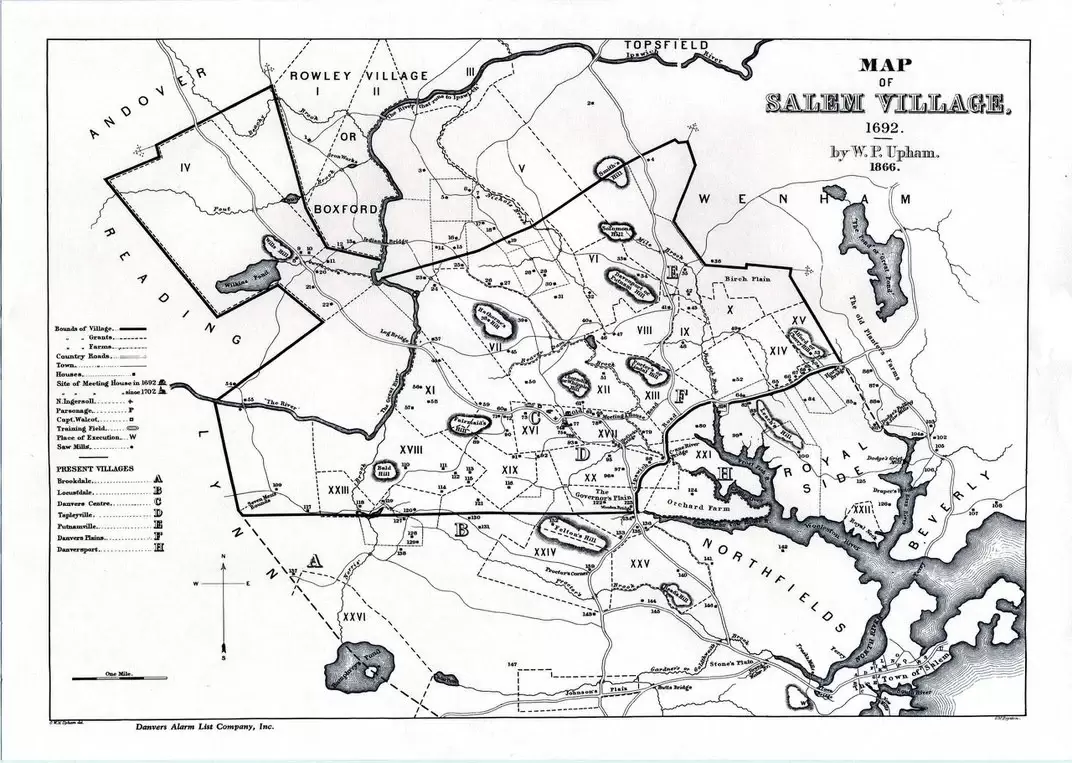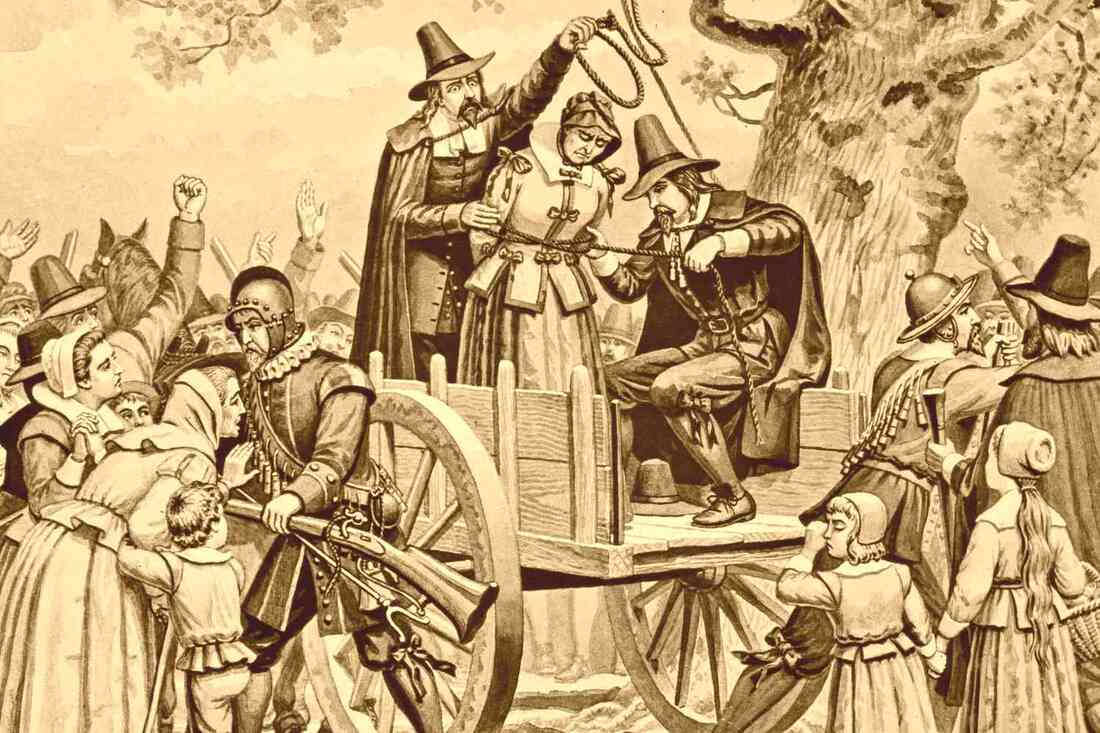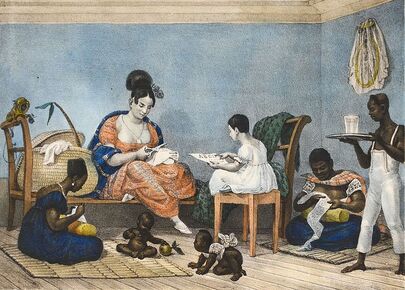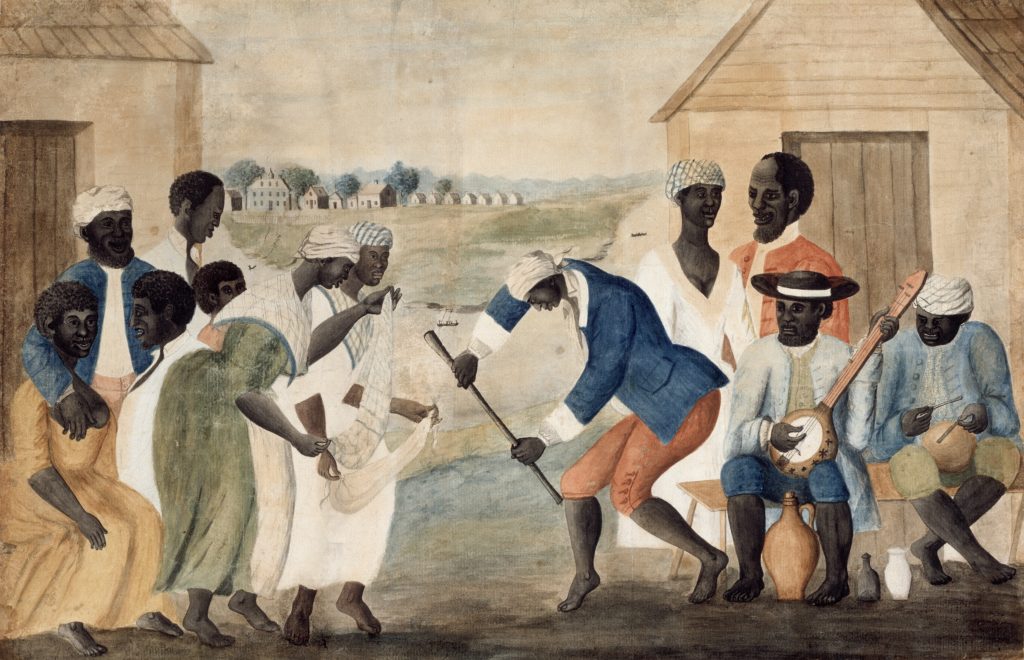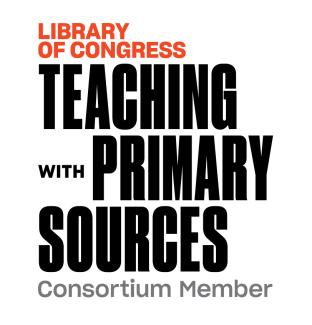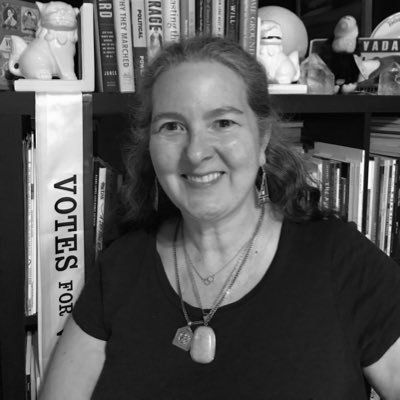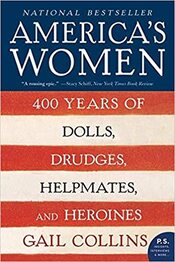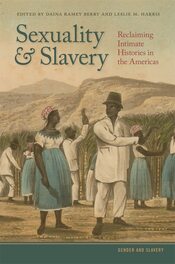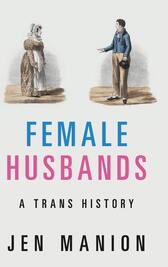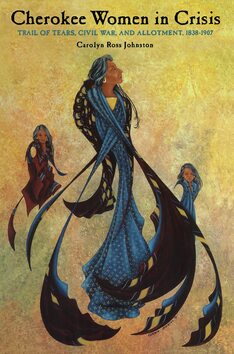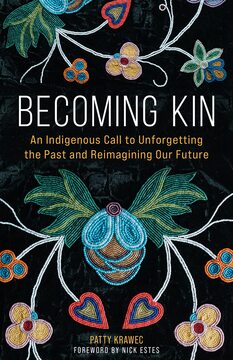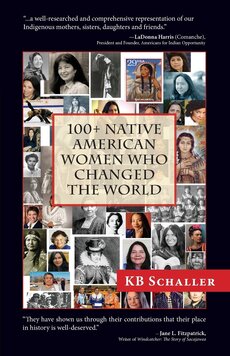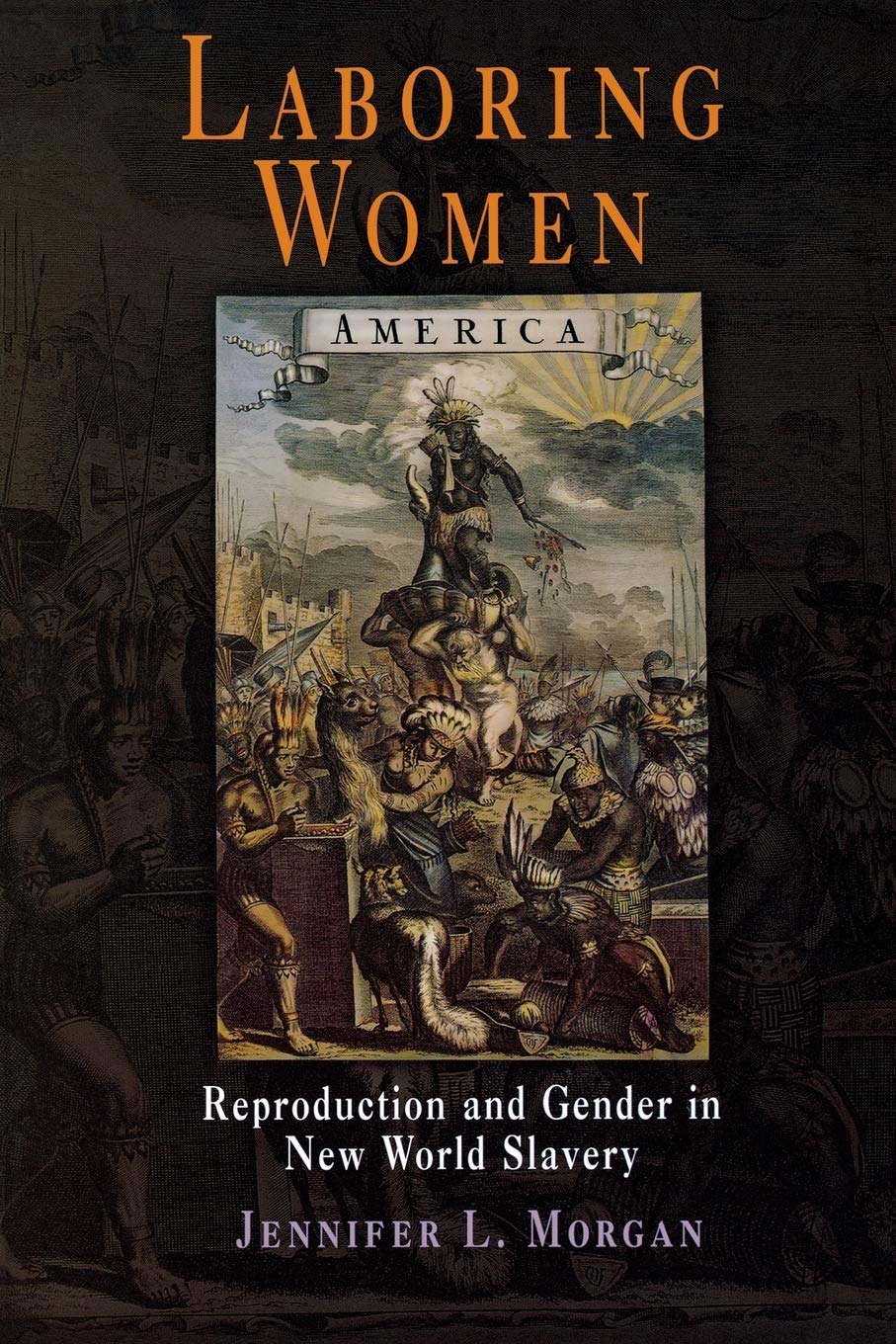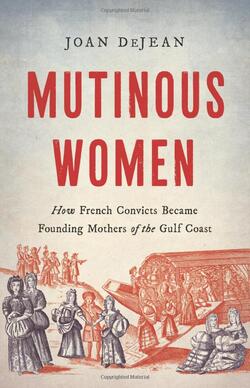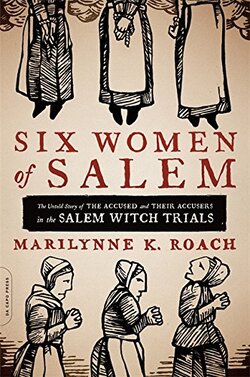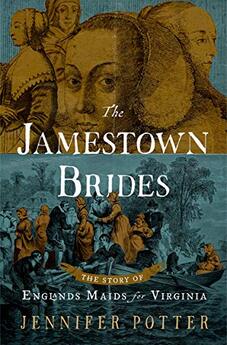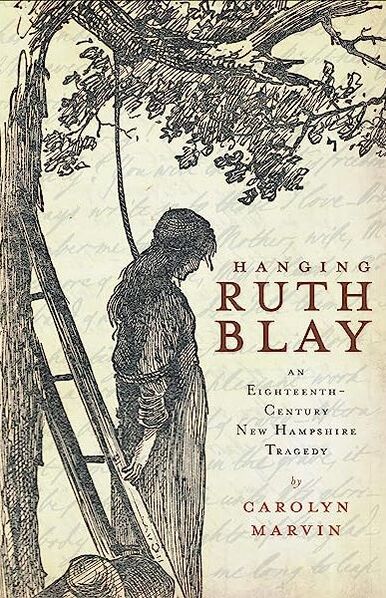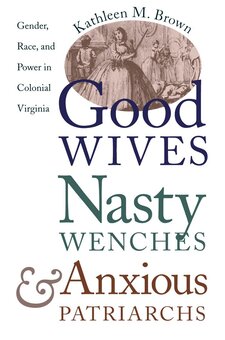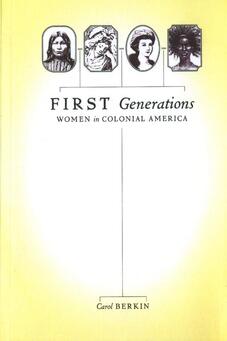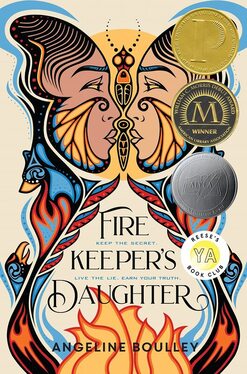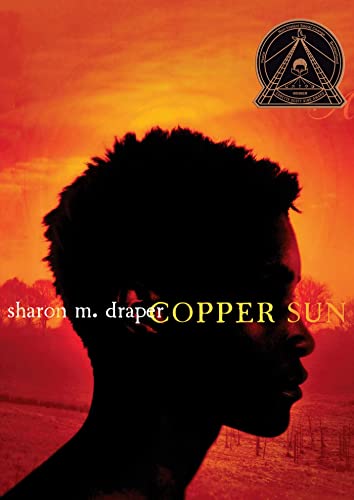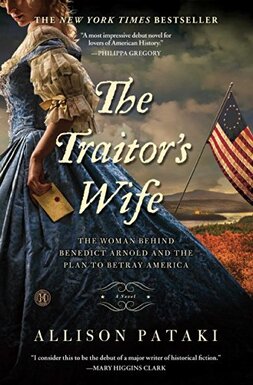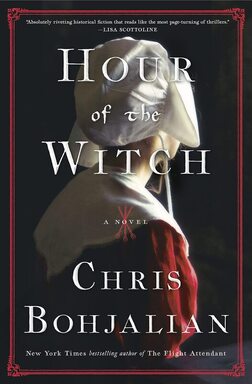3. Women’s Colonial Life
Life in Colonial America had many challenges. For women, the experience was both freeing in some respects–specifically from patriarchal controls–but also horrifying. This era would witness women who were able to acquire wealth through marriage and entrepreneurship, and women who would be burned at the stake for witchcraft. Undoubtedly, women’s experiences were incredibly diverse.
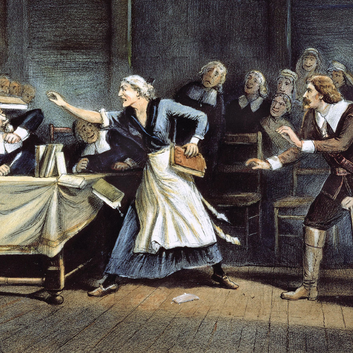 Witch Trials, Wikimedia Commons
Witch Trials, Wikimedia Commons
In the American colonies, women of the 1700s were greeted with horror after the overwhelmingly one-sided gendered massacre against women known as the Salem Witch Trials. Between 1692 and 1693 more than 200 people, mostly women, were accused of practicing witchcraft. 30 were found guilty, 19 were executed– 14 of those victims of superstition were women.
Worse, throughout the colonies, slavery was becoming synonymous with Blackness, and the conditions of servitude were becoming life sentences. Women in various states demonstrated their agency and lack of submission by leading slave rebellions.
Some women found opportunity in the religious movement of the period, known as the Great Awakening. For these women, this movement gave them more of a voice in churches and even resulted in some female preachers.
It was a time of tremendous change, solidifying footholds, colonial competition, and enduring restrictions on women’s rights and freedoms.
Worse, throughout the colonies, slavery was becoming synonymous with Blackness, and the conditions of servitude were becoming life sentences. Women in various states demonstrated their agency and lack of submission by leading slave rebellions.
Some women found opportunity in the religious movement of the period, known as the Great Awakening. For these women, this movement gave them more of a voice in churches and even resulted in some female preachers.
It was a time of tremendous change, solidifying footholds, colonial competition, and enduring restrictions on women’s rights and freedoms.
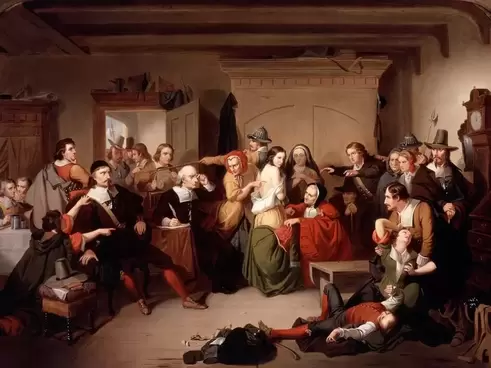 T.H. Matteson, Examination of a Witch, 1853, Wikimedia Commons
T.H. Matteson, Examination of a Witch, 1853, Wikimedia Commons
Salem Witch Trials:
The Salem Witch Trials in 1692 marked a dark period in American history. Three young girls in Salem Village—Betty Parris, her cousin Abigail Williams, and their friend Ann Putnam Jr.—displayed strange behaviors such as screaming, kicking, throwing objects, and contorting their bodies. A local doctor couldn't find a physical cause for their behavior and attributed the symptoms to witchcraft.
Witch trials and fear of witches had plagued Europe, and those fears had spread to the Americas. These trials typically targeted older women and provided little opportunity for them to defend themselves. Just fifty years prior, for example, hundreds of people, mostly women, were executed for witchcraft.
One early accused woman in America was Ann Hibbens of Boston. She was considered a witch simply for demanding quality work and expressing dissatisfaction with overcharging. Her execution was seen as a punishment for being more vocal than her neighbors.
Salem, Massachusetts became the center of the trials due to demographic displacement from King Philip's War, which reignited old rivalries. As for the three girls, they had traumatic childhoods. In their short lives, they had already been separated from their families, served as servants, and survived attacks by Native warriors. Betty and Abigail, living with troubled parents, sought help from an enslaved woman named Tituba. In a divination ritual, the girls became frightened by the imagery they saw, leading to their accusations of witchcraft.
Reverend Samuel Parris, Betty's father, pressed for answers regarding her behavior. Under pressure, Betty and her friend accused Tituba, Sarah Good (a homeless beggar), and Sarah Osborne (an elderly widow) of witchcraft. These marginalized women were easy targets for the accusations.
Sarah Good's four-year-old daughter, Dorcas, was also accused and imprisoned, enduring months of confinement. While she survived physically, the experience left her mentally disturbed for life.
Ann Putnam Jr. and her family actively accused others. Ann's parents desired inheritances that were rerouted to their stepmother's children, fueling their bitterness. The Putnam family accused 46 different people, and Ann's testimony led to numerous deaths. Her haunting nightmares of her deceased sister and other children contributed to her accusations against Tituba.
These girls didn't independently come up with their accusations. They were influenced by their parents and a legal system that took their claims seriously.
Under pressure and threats of torture, and despite being a devout Christian, Tituba confessed to witchcraft. Enslaved and lacking support, she likely felt she had no other choice. She accused the other two women as well.
The two women denied the accusations but were found guilty and executed. Tituba, spared from execution, remained imprisoned for over a year before being released. She never regained her previous life and died in obscurity.
The hysteria escalated, targeting wealthy and independent women. Martha Corey, convicted based on dubious witness testimonies, was accused of conversing with the devil and using witchcraft to harm others. Despite her denials, she was found guilty and sentenced to death. Rebecca Nurse, an older woman, was dragged from her home and forced to confront her accusers. With no strong defense against their dramatic behavior, she said, "I cannot tell what to think" and cried out for divine help. She was executed alongside four other women.
Increase Mather, the president of Harvard, warned against using "spectral evidence" in court, but the Salem court ignored his plea. Denying witchcraft allegations only fueled the belief in guilt. Mary Easty, a wealthy woman who refused to join the witch hunt, was also convicted and hanged.
While women were the majority of those convicted, men were also accused, often due to rivalries or family disputes. Giles Corey, Martha Corey's husband, was pressed to death with stones for refusing to enter a plea.
The legal process failed during the trials. The girls, primarily from the agrarian side of town, accused older and more powerful individuals from the wealthier side of town. Women constituted 14 out of the 20 convicted, mirroring previous European witch trials. The trials were conducted entirely by male juries, and recent studies suggest that the gender composition of juries influences the outcomes.
The trials ended in 1693 when public outcry led the governor of Massachusetts Bay Colony to dissolve the Court of Oyer and Terminer, responsible for the trials. Many convictions from the trials remain unresolved. The stories of the women involved serve as a reminder of the dangers of fear, superstition, and mass hysteria.
And this was only the beginning.
The Salem Witch Trials in 1692 marked a dark period in American history. Three young girls in Salem Village—Betty Parris, her cousin Abigail Williams, and their friend Ann Putnam Jr.—displayed strange behaviors such as screaming, kicking, throwing objects, and contorting their bodies. A local doctor couldn't find a physical cause for their behavior and attributed the symptoms to witchcraft.
Witch trials and fear of witches had plagued Europe, and those fears had spread to the Americas. These trials typically targeted older women and provided little opportunity for them to defend themselves. Just fifty years prior, for example, hundreds of people, mostly women, were executed for witchcraft.
One early accused woman in America was Ann Hibbens of Boston. She was considered a witch simply for demanding quality work and expressing dissatisfaction with overcharging. Her execution was seen as a punishment for being more vocal than her neighbors.
Salem, Massachusetts became the center of the trials due to demographic displacement from King Philip's War, which reignited old rivalries. As for the three girls, they had traumatic childhoods. In their short lives, they had already been separated from their families, served as servants, and survived attacks by Native warriors. Betty and Abigail, living with troubled parents, sought help from an enslaved woman named Tituba. In a divination ritual, the girls became frightened by the imagery they saw, leading to their accusations of witchcraft.
Reverend Samuel Parris, Betty's father, pressed for answers regarding her behavior. Under pressure, Betty and her friend accused Tituba, Sarah Good (a homeless beggar), and Sarah Osborne (an elderly widow) of witchcraft. These marginalized women were easy targets for the accusations.
Sarah Good's four-year-old daughter, Dorcas, was also accused and imprisoned, enduring months of confinement. While she survived physically, the experience left her mentally disturbed for life.
Ann Putnam Jr. and her family actively accused others. Ann's parents desired inheritances that were rerouted to their stepmother's children, fueling their bitterness. The Putnam family accused 46 different people, and Ann's testimony led to numerous deaths. Her haunting nightmares of her deceased sister and other children contributed to her accusations against Tituba.
These girls didn't independently come up with their accusations. They were influenced by their parents and a legal system that took their claims seriously.
Under pressure and threats of torture, and despite being a devout Christian, Tituba confessed to witchcraft. Enslaved and lacking support, she likely felt she had no other choice. She accused the other two women as well.
The two women denied the accusations but were found guilty and executed. Tituba, spared from execution, remained imprisoned for over a year before being released. She never regained her previous life and died in obscurity.
The hysteria escalated, targeting wealthy and independent women. Martha Corey, convicted based on dubious witness testimonies, was accused of conversing with the devil and using witchcraft to harm others. Despite her denials, she was found guilty and sentenced to death. Rebecca Nurse, an older woman, was dragged from her home and forced to confront her accusers. With no strong defense against their dramatic behavior, she said, "I cannot tell what to think" and cried out for divine help. She was executed alongside four other women.
Increase Mather, the president of Harvard, warned against using "spectral evidence" in court, but the Salem court ignored his plea. Denying witchcraft allegations only fueled the belief in guilt. Mary Easty, a wealthy woman who refused to join the witch hunt, was also convicted and hanged.
While women were the majority of those convicted, men were also accused, often due to rivalries or family disputes. Giles Corey, Martha Corey's husband, was pressed to death with stones for refusing to enter a plea.
The legal process failed during the trials. The girls, primarily from the agrarian side of town, accused older and more powerful individuals from the wealthier side of town. Women constituted 14 out of the 20 convicted, mirroring previous European witch trials. The trials were conducted entirely by male juries, and recent studies suggest that the gender composition of juries influences the outcomes.
The trials ended in 1693 when public outcry led the governor of Massachusetts Bay Colony to dissolve the Court of Oyer and Terminer, responsible for the trials. Many convictions from the trials remain unresolved. The stories of the women involved serve as a reminder of the dangers of fear, superstition, and mass hysteria.
And this was only the beginning.
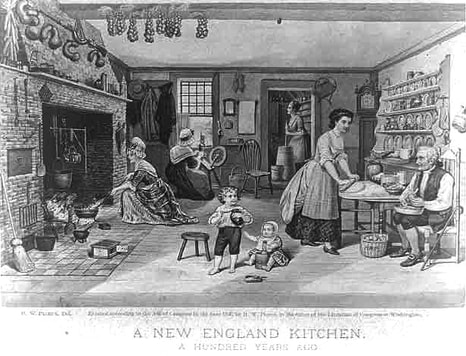 Colonial Life, Wikimedia Commons
Colonial Life, Wikimedia Commons
Life in Colonies:
Despite the grim end to the 1600s, life in the American colonies during the 1700s stabilized and in some ways improved for white women. White women in the American colonies contributed to their household and community’s success and wellbeing through a wide range of responsibilities, like: managing households, including tasks like baking, sewing, educating children, producing soap and candles, and supporting or running family businesses such as farming or shops.
While women had more children compared to today, infant mortality was high, with 1-3 out of 10 children dying before their fifth birthday. Giving birth was also dangerous, with a mortality rate of about 1 in 100 women (today, that number is closer to 32.9 per 100,000 or .0329 in 100). The availability of skilled midwives and the wealth of the colony often impacted maternal and infant mortality rates.
As the colonies stabilized and diversified, social classes started to emerge. In the 1700s women in the middle class often assisted their husbands in taverns, trades, or business ventures. However, despite their contributions, women had limited rights due to the concept of coverture. Coverture meant that women were socially, civilly, and legally represented and protected by their male heads of household, resulting in the denial of property and voting rights. Additionally, even though life expectancy was low, around 46-47 years old, becoming a widowed head of household did not grant women the right to vote.
Nevertheless, partnerships existed. In the colonial era, women were active participants in various cottage industries, such as textile production, pottery, candle making, and soap making. They often worked from home, utilizing their skills and creativity to produce goods that were essential for local consumption and trade. The operation and management of a household depended heavily on women’s work, and her work in the dairy, garden, kitchen, or spinning wheel was just as essential to the family’s well being as what her husband or father did in the fields or on a shipyard. As the Industrial Revolution gained momentum, women continued to be crucial contributors to the expanding manufacturing sector. They worked in factories, mills, and textile industries, operating machinery and performing tasks such as spinning, weaving, and assembling products. Women's labor and expertise were pivotal in fueling the early stages of industrialization, shaping not only the economic landscape but also paving the way for social and political advancements in the years to come.In fact, women and children were actually the most desirable workers in some of the first factories because they had fewer ties to the land and fewer obligations to agrarian farms. Plus, since women working out of the home–especially widows– were assumed to be in poverty and in economic desperation, they were a stable workforce whose labor could be purchased at a minimal cost.
Each colony had its own governing arrangements, with appointed colonial governors and colonial assemblies making decisions about taxes. However, these assemblies began to be disbanded by the British Parliament during the build-up to the American Revolution, which the colonists saw as evidence of corruption. Women had little participation in these political processes.
The colonies had their own distinct characteristics. New England states were heavily Puritan and placed a greater emphasis on education. They specialized in shipbuilding and craftsmanship. Southern colonies focused on cash crops like cotton and tobacco, aiming to export wealth back to England, resulting in fewer investments in cities and schools. The middle colonies, recently acquired from the Dutch, welcomed people from diverse backgrounds and engaged in farming, fishing, and merchant activities.
For free and upper-class women, life was relatively better, and notable outliers like Susanna Wright emerged. Susanna grew up in a Quaker family that emphasized equal education opportunities for girls. On the Pennsylvania frontier, she pursued intellectual and business interests, conducting botanical studies, writing essays, and serving as the chief clerk of the Wright's Ferry court. She advocated for the underprivileged in her community and cared for the sick, delving into medicinal herbs and medical science. Susanna also campaigned for fair treatment of Native communities facing displacement by English settlers, establishing her reputation in the Wright's Ferry community.
With financial independence from her father's successful ferry business and inherited lands, Susanna could pursue her scientific endeavors. She became the first person in Pennsylvania to successfully cultivate silkworms, exporting silk fibers to England for high-quality fabric production. Her achievements contributed to the development of silk worm farms and weaving factories among other colonies.
Susanna's prominence connected her with influential figures of the time, including Benjamin Franklin, with whom she maintained a close friendship. She acknowledged her privilege, recognizing that many women in the colonies had limited opportunities, compelled to subordinate themselves to the wishes of their fathers and husbands due to prevailing laws, religious practices, and social customs.
Despite the grim end to the 1600s, life in the American colonies during the 1700s stabilized and in some ways improved for white women. White women in the American colonies contributed to their household and community’s success and wellbeing through a wide range of responsibilities, like: managing households, including tasks like baking, sewing, educating children, producing soap and candles, and supporting or running family businesses such as farming or shops.
While women had more children compared to today, infant mortality was high, with 1-3 out of 10 children dying before their fifth birthday. Giving birth was also dangerous, with a mortality rate of about 1 in 100 women (today, that number is closer to 32.9 per 100,000 or .0329 in 100). The availability of skilled midwives and the wealth of the colony often impacted maternal and infant mortality rates.
As the colonies stabilized and diversified, social classes started to emerge. In the 1700s women in the middle class often assisted their husbands in taverns, trades, or business ventures. However, despite their contributions, women had limited rights due to the concept of coverture. Coverture meant that women were socially, civilly, and legally represented and protected by their male heads of household, resulting in the denial of property and voting rights. Additionally, even though life expectancy was low, around 46-47 years old, becoming a widowed head of household did not grant women the right to vote.
Nevertheless, partnerships existed. In the colonial era, women were active participants in various cottage industries, such as textile production, pottery, candle making, and soap making. They often worked from home, utilizing their skills and creativity to produce goods that were essential for local consumption and trade. The operation and management of a household depended heavily on women’s work, and her work in the dairy, garden, kitchen, or spinning wheel was just as essential to the family’s well being as what her husband or father did in the fields or on a shipyard. As the Industrial Revolution gained momentum, women continued to be crucial contributors to the expanding manufacturing sector. They worked in factories, mills, and textile industries, operating machinery and performing tasks such as spinning, weaving, and assembling products. Women's labor and expertise were pivotal in fueling the early stages of industrialization, shaping not only the economic landscape but also paving the way for social and political advancements in the years to come.In fact, women and children were actually the most desirable workers in some of the first factories because they had fewer ties to the land and fewer obligations to agrarian farms. Plus, since women working out of the home–especially widows– were assumed to be in poverty and in economic desperation, they were a stable workforce whose labor could be purchased at a minimal cost.
Each colony had its own governing arrangements, with appointed colonial governors and colonial assemblies making decisions about taxes. However, these assemblies began to be disbanded by the British Parliament during the build-up to the American Revolution, which the colonists saw as evidence of corruption. Women had little participation in these political processes.
The colonies had their own distinct characteristics. New England states were heavily Puritan and placed a greater emphasis on education. They specialized in shipbuilding and craftsmanship. Southern colonies focused on cash crops like cotton and tobacco, aiming to export wealth back to England, resulting in fewer investments in cities and schools. The middle colonies, recently acquired from the Dutch, welcomed people from diverse backgrounds and engaged in farming, fishing, and merchant activities.
For free and upper-class women, life was relatively better, and notable outliers like Susanna Wright emerged. Susanna grew up in a Quaker family that emphasized equal education opportunities for girls. On the Pennsylvania frontier, she pursued intellectual and business interests, conducting botanical studies, writing essays, and serving as the chief clerk of the Wright's Ferry court. She advocated for the underprivileged in her community and cared for the sick, delving into medicinal herbs and medical science. Susanna also campaigned for fair treatment of Native communities facing displacement by English settlers, establishing her reputation in the Wright's Ferry community.
With financial independence from her father's successful ferry business and inherited lands, Susanna could pursue her scientific endeavors. She became the first person in Pennsylvania to successfully cultivate silkworms, exporting silk fibers to England for high-quality fabric production. Her achievements contributed to the development of silk worm farms and weaving factories among other colonies.
Susanna's prominence connected her with influential figures of the time, including Benjamin Franklin, with whom she maintained a close friendship. She acknowledged her privilege, recognizing that many women in the colonies had limited opportunities, compelled to subordinate themselves to the wishes of their fathers and husbands due to prevailing laws, religious practices, and social customs.
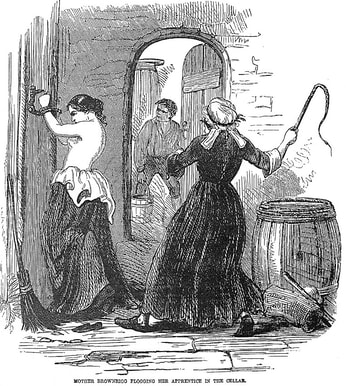 Woman Whipping an Indenture, Wikimedia Commons
Woman Whipping an Indenture, Wikimedia Commons
Indentured Women:
Many poor immigrants to the English colonies arrived as indentured servants, and faced a challenging and difficult experience. Indentured servitude involved signing a contract, or "indenture," which obligated individuals to work for a specific period in exchange for passage to the colonies and possibly the opportunity to learn a trade. This system affected people of different races, including whites, Indigenous individuals, and Blacks.
For women from impoverished backgrounds or without family support, indentured servitude became a means of survival. Poverty, debt, or unfavorable circumstances in their home countries drove many women to become indentured servants. Elizabeth Ashbridge, for instance, was a young, poor, and widowed English Quaker who came to the Americas as an indenture after being disowned by her father. The woman who convinced her to travel back to Pennsylvania bound her before boarding the ship. Ashbridge worked diligently to quickly pay off her indenture. Over time, she found faith and wrote an autobiography about her life as an influential religious leader during the revolutionary period.
Terms of indenture varied, usually lasting from four to seven years. Throughout this period, servants worked for their masters without receiving wages. Their tasks ranged from household chores to fieldwork or skilled trades, depending on their abilities and the needs of their masters.This also was usually determined by the type of indenture that they had. Apprenticeships were the most favorable type of indenture as the laborer would learn some type of handicraft, trade, or profession. These were typically male indenture agreements. Apprenticeships were rare, though, and most indenture agreements simply involved service. They endured physically demanding labor, often working long hours with minimal rest or leisure time. Living conditions were basic and crowded, with servants sharing small quarters and lacking privacy.
Indentured servants were considered the property of their masters and could be bought, sold, or transferred without their consent. Physical abuse, sexual exploitation, and mistreatment were common occurrences that often went unpunished due to the servants' legal status. Pregnancy posed additional challenges, as some women faced the prospect of raising a child while still in servitude. Despite the opportunity for a fresh start in the colonies, female servants found it difficult to improve their social standing or achieve economic independence. They encountered social stigma and had limited opportunities to acquire new skills or advance in society.
Upon completing their indentured servitude, female servants gained their freedom, but their prospects for a better life remained limited. Some indenture agreements had terms that provided for “freedom dues.” “Freedom dues” were farewell gifts of sorts. For apprentices, this might include the tools that would be necessary for the apprentice to establish their own business. Some indentured servant agreements indicated that the servant would receive a small parcel of land. These “freedom dues” varied from contract to contract–some agreements did not include “freedom dues,” but those that did were highly gendered. For men who were leaving their indenture to become self-sufficient heads of household, their “freedom dues” in the form of tools, materials, supplies, or land would help establish them on their way to self-mastery. For women, who were not expected to own land, their “freedom dues,” (if they received any) had to be small so that they could take them with them when they presumably married and moved onto the property that their husbands owned. We know, for example, of one indenture, Willy Honywell, who was to receive 25 acres of land and 12 bushels of corn once he completed his seven years of service. On the other hand, Alice Grinder, another indentured servant around the same time, only received two new outfits. Some women, upon completion of their indenture, managed to establish their own households or find employment, while many struggled to secure stable jobs and faced ongoing difficulties.
While there were some similarities between the status of indentured servants and the status of enslaved people (specifically the limits on their freedom during the tenure of their indenture in the form of rules governing marriage, and the ability to have their contract transferred or sold–usually upon the death of their master) it is important to note that indenture contracts eventually expired, indentured servants had a bit of free will, usually had to approve of their indenture agreement being sold or transferred, and had legal resources. Altogether, these distinctions in their situation made indentured servitude different from the lifelong servitude endured by enslaved individuals.
Many poor immigrants to the English colonies arrived as indentured servants, and faced a challenging and difficult experience. Indentured servitude involved signing a contract, or "indenture," which obligated individuals to work for a specific period in exchange for passage to the colonies and possibly the opportunity to learn a trade. This system affected people of different races, including whites, Indigenous individuals, and Blacks.
For women from impoverished backgrounds or without family support, indentured servitude became a means of survival. Poverty, debt, or unfavorable circumstances in their home countries drove many women to become indentured servants. Elizabeth Ashbridge, for instance, was a young, poor, and widowed English Quaker who came to the Americas as an indenture after being disowned by her father. The woman who convinced her to travel back to Pennsylvania bound her before boarding the ship. Ashbridge worked diligently to quickly pay off her indenture. Over time, she found faith and wrote an autobiography about her life as an influential religious leader during the revolutionary period.
Terms of indenture varied, usually lasting from four to seven years. Throughout this period, servants worked for their masters without receiving wages. Their tasks ranged from household chores to fieldwork or skilled trades, depending on their abilities and the needs of their masters.This also was usually determined by the type of indenture that they had. Apprenticeships were the most favorable type of indenture as the laborer would learn some type of handicraft, trade, or profession. These were typically male indenture agreements. Apprenticeships were rare, though, and most indenture agreements simply involved service. They endured physically demanding labor, often working long hours with minimal rest or leisure time. Living conditions were basic and crowded, with servants sharing small quarters and lacking privacy.
Indentured servants were considered the property of their masters and could be bought, sold, or transferred without their consent. Physical abuse, sexual exploitation, and mistreatment were common occurrences that often went unpunished due to the servants' legal status. Pregnancy posed additional challenges, as some women faced the prospect of raising a child while still in servitude. Despite the opportunity for a fresh start in the colonies, female servants found it difficult to improve their social standing or achieve economic independence. They encountered social stigma and had limited opportunities to acquire new skills or advance in society.
Upon completing their indentured servitude, female servants gained their freedom, but their prospects for a better life remained limited. Some indenture agreements had terms that provided for “freedom dues.” “Freedom dues” were farewell gifts of sorts. For apprentices, this might include the tools that would be necessary for the apprentice to establish their own business. Some indentured servant agreements indicated that the servant would receive a small parcel of land. These “freedom dues” varied from contract to contract–some agreements did not include “freedom dues,” but those that did were highly gendered. For men who were leaving their indenture to become self-sufficient heads of household, their “freedom dues” in the form of tools, materials, supplies, or land would help establish them on their way to self-mastery. For women, who were not expected to own land, their “freedom dues,” (if they received any) had to be small so that they could take them with them when they presumably married and moved onto the property that their husbands owned. We know, for example, of one indenture, Willy Honywell, who was to receive 25 acres of land and 12 bushels of corn once he completed his seven years of service. On the other hand, Alice Grinder, another indentured servant around the same time, only received two new outfits. Some women, upon completion of their indenture, managed to establish their own households or find employment, while many struggled to secure stable jobs and faced ongoing difficulties.
While there were some similarities between the status of indentured servants and the status of enslaved people (specifically the limits on their freedom during the tenure of their indenture in the form of rules governing marriage, and the ability to have their contract transferred or sold–usually upon the death of their master) it is important to note that indenture contracts eventually expired, indentured servants had a bit of free will, usually had to approve of their indenture agreement being sold or transferred, and had legal resources. Altogether, these distinctions in their situation made indentured servitude different from the lifelong servitude endured by enslaved individuals.
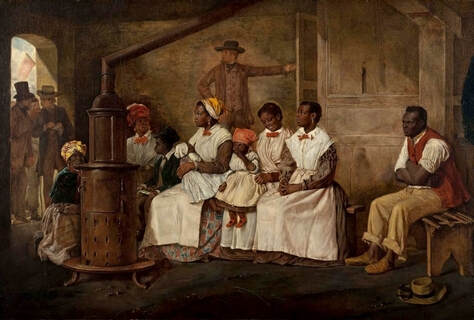 Slaves Waiting for Sale - Richmond, Virginia by Eyre Crowe, 1853.
Slaves Waiting for Sale - Richmond, Virginia by Eyre Crowe, 1853.
Enslaved Women:
Enslaved women and girls had no such privileges. From a young age, girls were assigned small tasks like picking up trash, tending to younger children, cleaning cotton, or scaring birds away from newly planted rice fields. As they reached adolescence, enslaved girls typically took on more regular labor. Older women who could no longer work in the fields were sometimes tasked with caring for enslaved children. The work patterns of enslaved women varied throughout their lives and according to the region they were in as enslavers aimed to extract maximum profits from their labor.
Apart from their physical and reproductive labor, enslaved women were subjected to the oppressive demands of fulfilling the sexual desires of slaveholders, overseers, and other men in positions of power. The colony of Virginia, quickly followed by other colonies, passed a law in 1662 that laid out the principle of partus sequitur ventrem, or, “that which is born follows the womb.” This essentially dictated that the status of any child born would be based on the status–free or enslaved–of its mother and regardless of their father's legal standing. In other words, enslaved women gave birth to children who would inherit the status of slavery. While this was described as a way to settle questions about whether children should be free or enslaved based on some current questions the colony was having, it alsogave slave owners incentives to rape their enslaved women in order for them to produce more slaves. Obviously this cast a long shadow over the lives of enslaved women. While enslaved women’s experiences in slavery share many aspects in common with their male counterparts, the reality is also that for enslaved women, this reproductive dimension added another dimension to their experiences that cannot wholly be understood by the rest of us. Because enslaved women were workers, mothers, and survivors of sexual assault (enslaved women cannot provide true consent), one historian has argued that enslaved women were then “either especially oppressed or comparatively privileged” (perhaps in terms of material comfort).
Women dominated the ranks of the enslaved people who worked in the homes of slaveholders because this work was considered "domestic" and traditionally associated with women and girls. House duties encompassed a wide range of responsibilities, including cleaning, cooking, washing, and caring for all members of the white family, from adults to infants. Consequently, many enslaved women of various ages spent a significant portion of their adult lives working within the homes of their white enslavers. These women were both close to their enslavers and also more monitored by them: which proved to be a strange predicament. Many of these women dedicated their time to caring for children, undertaking tasks such as clothing, feeding, and bathing them. Enslaved women who were lactating (producing milk) even served as wet nurses for white infants, sometimes being forced to wean their own child early in order to prioritize the wellbeing of their masters’ baby.
Gradually, slaveholders created a stereotype of an older domestic woman, often known as the "mammy." Typically, this caricature was of a loyal, overweight or obese woman who was conventionally unattractive yet devoted to the family. This trope of a Black woman: solely devoted to her work and obedient, was used to justify slavery. Enslavers argued these women wouldn’t be so obedient if they didn’t really love the family that enslaved them. This caricature was also used as a shield to cover for some of the sexual abuses taking place within the Southern home. The mammy caricature is explicitly desexualized. She was designed to portray unattractiveness. This move to convey the mammy as older and overweight implicitly meant that the slave owner’s wife and family were safe. No reasonable white man would want to have sex with her. Though we know that sexual assault, and unequal relationships existed between masters and enslaved women, the mammy lie conveyed the idea that Black women were undesirable, existed to serve white families, and supported the institution of slavery.
White women often upheld the system of slavery and benefited from it. The typical female slave owner, as well as the average male slave owner, claimed legal ownership of 10 enslaved individuals or fewer. It is important to remember that most slaves in the South were concentrated in the hands of a small share of slave owners. Over time in the South, the proportion of those southerners who owned slaves shrank. The vast majority of slaveowners in the South were of the small farm or middling sort. These slaveowners had less than ten, but no more than 50 slaves. The elite among slaveowners held in their possession 50 slaves or more, and the best land, and enough of it to make that investment in labor profitable. That being said, in most cases, their ownership extended to fewer than five people. Young white girls often received enslaved people as gifts, even as infants. As when we talked about indentured servants and their freedom dues, those gifts needed to be something that the women could take with them. It was not uncommon for women to receive slaves as wedding gifts–particularly with the expectation that they might serve as wet nurses when the bride became pregnant. Women also purchased them from slave markets across the Southern region. White women were a part of the culture of slavery. While their responses to slavery varied, most were responsible for at least directing the house slave and clothing and feeding their slaves. Like men, Southern slave owning women could be benevolent enslavers, or they could be incredibly cruel, and were just as likely to inflict violent punishments upon their slaves. One woman starved her enslaved people and taunted them with candies. When one girl succumbed to her hunger, the slaver rocked her rocking chair atop the girl's head while her daughter whipped her, permanently deforming her jaw. The inclusion of her white daughter as the whipper shows how the violence of slavery was something that was taught from generation to generation.
Enslaved women and girls had no such privileges. From a young age, girls were assigned small tasks like picking up trash, tending to younger children, cleaning cotton, or scaring birds away from newly planted rice fields. As they reached adolescence, enslaved girls typically took on more regular labor. Older women who could no longer work in the fields were sometimes tasked with caring for enslaved children. The work patterns of enslaved women varied throughout their lives and according to the region they were in as enslavers aimed to extract maximum profits from their labor.
Apart from their physical and reproductive labor, enslaved women were subjected to the oppressive demands of fulfilling the sexual desires of slaveholders, overseers, and other men in positions of power. The colony of Virginia, quickly followed by other colonies, passed a law in 1662 that laid out the principle of partus sequitur ventrem, or, “that which is born follows the womb.” This essentially dictated that the status of any child born would be based on the status–free or enslaved–of its mother and regardless of their father's legal standing. In other words, enslaved women gave birth to children who would inherit the status of slavery. While this was described as a way to settle questions about whether children should be free or enslaved based on some current questions the colony was having, it alsogave slave owners incentives to rape their enslaved women in order for them to produce more slaves. Obviously this cast a long shadow over the lives of enslaved women. While enslaved women’s experiences in slavery share many aspects in common with their male counterparts, the reality is also that for enslaved women, this reproductive dimension added another dimension to their experiences that cannot wholly be understood by the rest of us. Because enslaved women were workers, mothers, and survivors of sexual assault (enslaved women cannot provide true consent), one historian has argued that enslaved women were then “either especially oppressed or comparatively privileged” (perhaps in terms of material comfort).
Women dominated the ranks of the enslaved people who worked in the homes of slaveholders because this work was considered "domestic" and traditionally associated with women and girls. House duties encompassed a wide range of responsibilities, including cleaning, cooking, washing, and caring for all members of the white family, from adults to infants. Consequently, many enslaved women of various ages spent a significant portion of their adult lives working within the homes of their white enslavers. These women were both close to their enslavers and also more monitored by them: which proved to be a strange predicament. Many of these women dedicated their time to caring for children, undertaking tasks such as clothing, feeding, and bathing them. Enslaved women who were lactating (producing milk) even served as wet nurses for white infants, sometimes being forced to wean their own child early in order to prioritize the wellbeing of their masters’ baby.
Gradually, slaveholders created a stereotype of an older domestic woman, often known as the "mammy." Typically, this caricature was of a loyal, overweight or obese woman who was conventionally unattractive yet devoted to the family. This trope of a Black woman: solely devoted to her work and obedient, was used to justify slavery. Enslavers argued these women wouldn’t be so obedient if they didn’t really love the family that enslaved them. This caricature was also used as a shield to cover for some of the sexual abuses taking place within the Southern home. The mammy caricature is explicitly desexualized. She was designed to portray unattractiveness. This move to convey the mammy as older and overweight implicitly meant that the slave owner’s wife and family were safe. No reasonable white man would want to have sex with her. Though we know that sexual assault, and unequal relationships existed between masters and enslaved women, the mammy lie conveyed the idea that Black women were undesirable, existed to serve white families, and supported the institution of slavery.
White women often upheld the system of slavery and benefited from it. The typical female slave owner, as well as the average male slave owner, claimed legal ownership of 10 enslaved individuals or fewer. It is important to remember that most slaves in the South were concentrated in the hands of a small share of slave owners. Over time in the South, the proportion of those southerners who owned slaves shrank. The vast majority of slaveowners in the South were of the small farm or middling sort. These slaveowners had less than ten, but no more than 50 slaves. The elite among slaveowners held in their possession 50 slaves or more, and the best land, and enough of it to make that investment in labor profitable. That being said, in most cases, their ownership extended to fewer than five people. Young white girls often received enslaved people as gifts, even as infants. As when we talked about indentured servants and their freedom dues, those gifts needed to be something that the women could take with them. It was not uncommon for women to receive slaves as wedding gifts–particularly with the expectation that they might serve as wet nurses when the bride became pregnant. Women also purchased them from slave markets across the Southern region. White women were a part of the culture of slavery. While their responses to slavery varied, most were responsible for at least directing the house slave and clothing and feeding their slaves. Like men, Southern slave owning women could be benevolent enslavers, or they could be incredibly cruel, and were just as likely to inflict violent punishments upon their slaves. One woman starved her enslaved people and taunted them with candies. When one girl succumbed to her hunger, the slaver rocked her rocking chair atop the girl's head while her daughter whipped her, permanently deforming her jaw. The inclusion of her white daughter as the whipper shows how the violence of slavery was something that was taught from generation to generation.
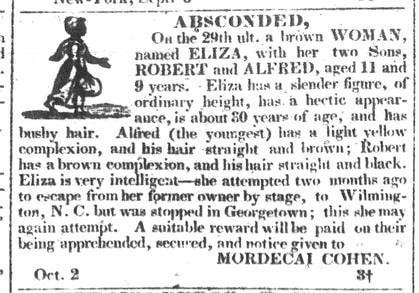 Absconded, Runaway Slave Advertisement for Eliza, Public Domain
Absconded, Runaway Slave Advertisement for Eliza, Public Domain
Rebel Women:
Enslaved people actively resisted slavery, by rebelling, slowing down work, and running away. Enslaved women and girls sought freedom as soon as they arrived in the Americas, with some choosing collective escapes while others fled individually. The timing of their escapes varied, as some women made their break for freedom immediately upon arrival, while others did so within weeks or even months later. An example is Juno, a fifteen-year-old girl who arrived on the slave ship Speaker in Charleston, SC on June 16, 1733. Just two weeks after being sold to a planter from Dorchester, Juno managed to escape. These acts of self-emancipation by enslaved Black individuals show the consistency with which women resisted bondage.
Some responded with violence to the violence they endured as slaves. In 1708, an enslaved Indigenous man named Sam and a woman identified only as a "Negro Fiend" murdered their master and his pregnant wife, leading to their capture. Sam was hanged, and the woman was burned at the stake due to an English law regarding treason. A few years later, a significant rebellion occurred in New York in 1712, involving Black slaves who killed nine white individuals and injured six others. The uprising resulted in the arrest of over 70 enslaved people, with 27 put on trial, including four women named Sarah, Abigail, Lily, and Amba. The historical record provides limited information on these women's opinions, except for a statement indicating they had made previous statements for themselves. Sarah and Abigail, along with 19 others, were convicted and sentenced to death. However, one of the women was pregnant, leading to a delayed hanging. The fate of the unnamed girl remained uncertain due to political turmoil in England.
Rebellions continued across the colonies, with the New York governor's house being destroyed by a fire in 1741. Multiple fires occurred in subsequent days, leading to suspicions of another rebellion. A white indentured servant named Mary Burton claimed a conspiracy involving dozens of enslaved people attempting to overthrow the colonial government, causing panic among white individuals. Sarah, an enslaved woman, was accused by four people of deep involvement, resulting in her collapsing in fits and foaming at the mouth during court proceedings. Sarah faced intense interrogation, leading to the execution of alleged conspirators. As a consequence, she was sent to a sugar plantation in the Caribbean, essentially a death sentence.
While rebellions demonstrated the humanity and desire for autonomy and freedom among enslaved people, they also resulted in tighter control and scrutiny over the enslaved population. For example, a rebellion in South Carolina in 1739 led to laws requiring a 1:10 ratio between slave masters and slaves as well as imposing prohibitions on growing their own food, assembling in groups, earning money, and learning to read.
Enslaved people actively resisted slavery, by rebelling, slowing down work, and running away. Enslaved women and girls sought freedom as soon as they arrived in the Americas, with some choosing collective escapes while others fled individually. The timing of their escapes varied, as some women made their break for freedom immediately upon arrival, while others did so within weeks or even months later. An example is Juno, a fifteen-year-old girl who arrived on the slave ship Speaker in Charleston, SC on June 16, 1733. Just two weeks after being sold to a planter from Dorchester, Juno managed to escape. These acts of self-emancipation by enslaved Black individuals show the consistency with which women resisted bondage.
Some responded with violence to the violence they endured as slaves. In 1708, an enslaved Indigenous man named Sam and a woman identified only as a "Negro Fiend" murdered their master and his pregnant wife, leading to their capture. Sam was hanged, and the woman was burned at the stake due to an English law regarding treason. A few years later, a significant rebellion occurred in New York in 1712, involving Black slaves who killed nine white individuals and injured six others. The uprising resulted in the arrest of over 70 enslaved people, with 27 put on trial, including four women named Sarah, Abigail, Lily, and Amba. The historical record provides limited information on these women's opinions, except for a statement indicating they had made previous statements for themselves. Sarah and Abigail, along with 19 others, were convicted and sentenced to death. However, one of the women was pregnant, leading to a delayed hanging. The fate of the unnamed girl remained uncertain due to political turmoil in England.
Rebellions continued across the colonies, with the New York governor's house being destroyed by a fire in 1741. Multiple fires occurred in subsequent days, leading to suspicions of another rebellion. A white indentured servant named Mary Burton claimed a conspiracy involving dozens of enslaved people attempting to overthrow the colonial government, causing panic among white individuals. Sarah, an enslaved woman, was accused by four people of deep involvement, resulting in her collapsing in fits and foaming at the mouth during court proceedings. Sarah faced intense interrogation, leading to the execution of alleged conspirators. As a consequence, she was sent to a sugar plantation in the Caribbean, essentially a death sentence.
While rebellions demonstrated the humanity and desire for autonomy and freedom among enslaved people, they also resulted in tighter control and scrutiny over the enslaved population. For example, a rebellion in South Carolina in 1739 led to laws requiring a 1:10 ratio between slave masters and slaves as well as imposing prohibitions on growing their own food, assembling in groups, earning money, and learning to read.
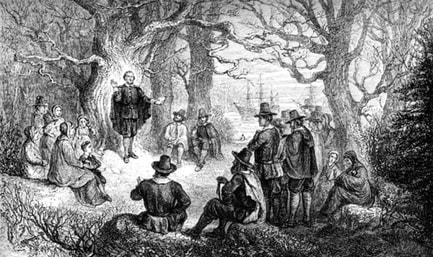 Great Awakening, Wikimedia Commons
Great Awakening, Wikimedia Commons
First Great Awakening:
Whether white, Black, free, indentured, or enslaved, religion and religious beliefs played an important role in the American colonies. The First Great Awakening in the 1730s-40s had a significant impact on women's subordinate status in the colonies. It was a period of intense religious enthusiasm that marked a significant shift in the religious landscape as many Americans renewed their commitment to God. The prevailing belief emphasized God's unlimited power and the necessity of fearing and following Him to attain salvation and avoid damnation. Notably, a large number of enslaved and Indigenous people converted to Christianity during this time.
Unlike previous emphasis on formal theology, the focus during the Great Awakening shifted to cultivating personal experiences of salvation and fostering a heartfelt connection with God. This revival sparked the emergence of a new generation of ministers, including women. However, these religious women were still constrained by societal expectations and the view that women's involvement in public or mixed-gender settings was improper. Nonetheless, women found ways to participate.
For instance, Mary Reed had visions that she shared privately with her minister, who then relayed them to the congregation while Mary remained calmly seated in the pews. Her humble demeanor bestowed authority upon her words among the worshipers. Although women were not allowed to publicly preach in the church, a notable difference with Great Awakening preachers was that they took their message outside the church to the unconverted. In open-air settings, women's voices could be heard.
Martha Stearns Marshall was a renowned preacher who moved her congregation to tears. She and her husband underwent a conversion during the revival, leading them to live among the Mohawk Indians in an attempt to bring them to Christianity. When war broke out, they settled in Virginia, North Carolina, and later Georgia. The Separate Baptists church Marshall belonged to differed from the "Regular" Baptists in that they granted women a more prominent role in worship and church leadership. Women served as deaconesses and eldresses and actively engaged in preaching.
Marshall was not the only influential female preacher. Sarah Wright Townsend, a Long Island school teacher, exhorted for over fifteen years on Sundays. Bathsheba Kingsley, known as the "brawling woman," fearlessly embarked on a journey from town to town, spreading the message of faith and confronting townsfolk about their sinful ways. Jamima Wilkinson transcended gender boundaries and delivered passionate sermons, evoking both fascination and disgust while adorned in a flowing robe.
Some women struggled to navigate the complexities of spiritual equality and social inferiority. Margaret Meuse Clay, a pious woman, was asked to lead public prayers in her church. However, her preaching was deemed excessive, leading to her and eleven male Baptists being sentenced to a public whipping for unlicensed preaching. She was spared when an unnamed man paid her fine. These struggles were compounded by factors such as race and class.Though evidence is fragmentary, it is believed that enslaved women may have served as evangelists on plantations. Stories passed down through later generations of slaves mention grandmothers and great-grandmothers exhorting in slave quarters.
Religion deeply influenced various aspects of women's lives, shaping their perspectives on suffering, marriage, motherhood, the body, and sexuality. For countless women, religion served as a guiding force, providing a sense of direction and allowing them to comprehend their position in the world. The societal changes brought about by the Great Awakening were remarkable, with traditional roles shifting as wives encouraged their husbands to pursue piety. Children became evangelists for their parents, and in a bold move, some women spoke publicly about their faith. As described by one Reverend, many individuals became so deeply engrossed in their religious fervor that they appeared temporarily disconnected from reality.
Whether white, Black, free, indentured, or enslaved, religion and religious beliefs played an important role in the American colonies. The First Great Awakening in the 1730s-40s had a significant impact on women's subordinate status in the colonies. It was a period of intense religious enthusiasm that marked a significant shift in the religious landscape as many Americans renewed their commitment to God. The prevailing belief emphasized God's unlimited power and the necessity of fearing and following Him to attain salvation and avoid damnation. Notably, a large number of enslaved and Indigenous people converted to Christianity during this time.
Unlike previous emphasis on formal theology, the focus during the Great Awakening shifted to cultivating personal experiences of salvation and fostering a heartfelt connection with God. This revival sparked the emergence of a new generation of ministers, including women. However, these religious women were still constrained by societal expectations and the view that women's involvement in public or mixed-gender settings was improper. Nonetheless, women found ways to participate.
For instance, Mary Reed had visions that she shared privately with her minister, who then relayed them to the congregation while Mary remained calmly seated in the pews. Her humble demeanor bestowed authority upon her words among the worshipers. Although women were not allowed to publicly preach in the church, a notable difference with Great Awakening preachers was that they took their message outside the church to the unconverted. In open-air settings, women's voices could be heard.
Martha Stearns Marshall was a renowned preacher who moved her congregation to tears. She and her husband underwent a conversion during the revival, leading them to live among the Mohawk Indians in an attempt to bring them to Christianity. When war broke out, they settled in Virginia, North Carolina, and later Georgia. The Separate Baptists church Marshall belonged to differed from the "Regular" Baptists in that they granted women a more prominent role in worship and church leadership. Women served as deaconesses and eldresses and actively engaged in preaching.
Marshall was not the only influential female preacher. Sarah Wright Townsend, a Long Island school teacher, exhorted for over fifteen years on Sundays. Bathsheba Kingsley, known as the "brawling woman," fearlessly embarked on a journey from town to town, spreading the message of faith and confronting townsfolk about their sinful ways. Jamima Wilkinson transcended gender boundaries and delivered passionate sermons, evoking both fascination and disgust while adorned in a flowing robe.
Some women struggled to navigate the complexities of spiritual equality and social inferiority. Margaret Meuse Clay, a pious woman, was asked to lead public prayers in her church. However, her preaching was deemed excessive, leading to her and eleven male Baptists being sentenced to a public whipping for unlicensed preaching. She was spared when an unnamed man paid her fine. These struggles were compounded by factors such as race and class.Though evidence is fragmentary, it is believed that enslaved women may have served as evangelists on plantations. Stories passed down through later generations of slaves mention grandmothers and great-grandmothers exhorting in slave quarters.
Religion deeply influenced various aspects of women's lives, shaping their perspectives on suffering, marriage, motherhood, the body, and sexuality. For countless women, religion served as a guiding force, providing a sense of direction and allowing them to comprehend their position in the world. The societal changes brought about by the Great Awakening were remarkable, with traditional roles shifting as wives encouraged their husbands to pursue piety. Children became evangelists for their parents, and in a bold move, some women spoke publicly about their faith. As described by one Reverend, many individuals became so deeply engrossed in their religious fervor that they appeared temporarily disconnected from reality.
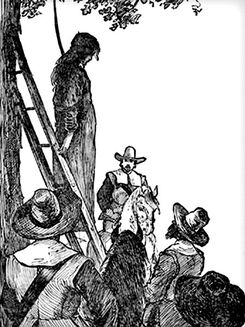 Engraving of a Women at Execution, Public Domain
Engraving of a Women at Execution, Public Domain
Colonial Laws:
Whether enslaved, Indigenous, or white, upper class or lower class, women suffered under a prejudiced legal system. Problems evident at Salem, still existed by the end of the colonial period. Women took no part in designing laws and could be accused, arrested, tried, and executed by all-male rule makers and enforcers. In the colonial period, we can learn a lot about the lives of women through court records, although we have taken these sources with a grain of salt. They are not representative of the majority of women, instead these are examples of the more extreme experiences women had. Furthermore, many of these sources were written by men about the women who were accused, and we rarely have sources provided by the women themselves. Based on verifiable sources, women were mostly executed on charges related to murder, attempted murder, or conspiracy to commit murder. Some were charged with witchcraft, and not just in Massachusetts. In fact, the first woman executed for witchcraft was in Virginia. Still others were accused of arson and one woman was executed for the crime of adultery.
Aside from those criminal acts, having a child outside of wedlock carried significant social stigma in colonial America. For example, when Anne Orthwood became pregnant out of wedlock with twins in late 17th century Virginia, she became the subject of four different cases–civil and criminal–stemming from her indenture being affected by her pregnancy, demands for child support, criminal fornication, and then a case much later when her only surviving twin tried to free himself from his indenture (Anne, unfortunately, died in childbirth). Orthwood’s case was unique because the father of her child was related to a wealthy politician. Anne’s status as an indentured servant likely played a role in her lover’s decision to end the relationship and deny paternity.
To cope with a rigid society in a time before effective contraceptives and sex education, abortion was common and legal up until the “quickening period.” Quickening was when the mother experienced fetal movement. Some women likely induced miscarriages because they feared social stigma, but that wasn’t always the case.Some women knew they could not provide for their babies emotionally, financially, or physically.
Some women were charged with infanticide, infanticide is the act of killing an infant after it is born. While this crime is hard to imagine or understand, it’s important to refrain from looking at these issues through our modern lens and to attempt to humanize the subjects we study. In a time before formula or intravenous nutrition, and when infant mortality was high, a mother who couldn’t breastfeed, or a child who was ill or wouldn’t latch, there weren’t really options outside of a wet nurse. Animal milk is bad for infant digestive systems and wouldn’t have helped. If another lactating woman was not available, these poor mothers were often stuck in the impossible scenario of watching their baby starve, or ending their suffering. It’s hard to imagine the pain of then being charged with murdering your child–particularly when we consider the circumstances that led to it.
Women were heavily policed under English law in order to protect paternity, fatherhood, and property. At one point, concealing the birth of an illegitimate child was also considered a capital offense. Concealment was punishable by death if the baby did not survive. With no one to witness a “concealed” birth, there was no one to prove that the child had been born dead and–perhaps in a recognition of the social stigma of a child out of wedlock–the dead infant was considered a murder victim unless the mother could prove her innocence. Five women in colonial America were hanged for concealing pregnancies: three in New Hampshire alone. Again, the legal system failed women. The burden of proof did not require evidence of intent. These laws were later seen as symbolic of the corruption of the British crown, but were probably more symbolic of the rampant misogyny embedded in these systems that stripped women of their personhood.
Ruth Blay was one of the women executed in New Hampshire for concealment. She was a poor school teacher who was likely impregnated by a prominent married man in her community. When she realized she was pregnant she left her teaching post to live with distant relatives with whom there was a generations old family feud that she hoped would not be used against her. When she went into labor, she delivered alone in a barn. The baby was stillborn and soon discovered by children buried under the barn. Blay was inspected by local male physicians and accused of concealment.
She was dragged from her temporary home to a prison in Portsmouth. Her siblings came and testified on her behalf, but whatever they said in defense is lost. The entirely male jury found her guilty. The colonial governor gave her reprieves but eventually she was hanged from a tree in December 1768, like all the women at Salem before her, by a legal system that gave women little choices.
The day after Ruth was hanged, she published her last words in the paper: “The time being now short after returning Thanks to all Friends for the kindness shown me, I must bid them farewell… my Conscience is clear with respect to my poor Infant;-- And though I die with a forgiving Spirit as to all my Enemies, but charge two women in particular to examine their own Hearts, as they will answer to it another day– whether they do not come under the Character of false witnesses?-- And whether Prejudice, Jealousy, or something else has not drove them thus to bear false Witness against me.”
Why did women at Salem tell on each other? Why did white women enslave their Black sisters and steal land from their Indigenous sisters? Why did women testify against each other, like with Ruth? Would things have been different with education, rights, and a voice in public spaces? We can only speculate.
Whether enslaved, Indigenous, or white, upper class or lower class, women suffered under a prejudiced legal system. Problems evident at Salem, still existed by the end of the colonial period. Women took no part in designing laws and could be accused, arrested, tried, and executed by all-male rule makers and enforcers. In the colonial period, we can learn a lot about the lives of women through court records, although we have taken these sources with a grain of salt. They are not representative of the majority of women, instead these are examples of the more extreme experiences women had. Furthermore, many of these sources were written by men about the women who were accused, and we rarely have sources provided by the women themselves. Based on verifiable sources, women were mostly executed on charges related to murder, attempted murder, or conspiracy to commit murder. Some were charged with witchcraft, and not just in Massachusetts. In fact, the first woman executed for witchcraft was in Virginia. Still others were accused of arson and one woman was executed for the crime of adultery.
Aside from those criminal acts, having a child outside of wedlock carried significant social stigma in colonial America. For example, when Anne Orthwood became pregnant out of wedlock with twins in late 17th century Virginia, she became the subject of four different cases–civil and criminal–stemming from her indenture being affected by her pregnancy, demands for child support, criminal fornication, and then a case much later when her only surviving twin tried to free himself from his indenture (Anne, unfortunately, died in childbirth). Orthwood’s case was unique because the father of her child was related to a wealthy politician. Anne’s status as an indentured servant likely played a role in her lover’s decision to end the relationship and deny paternity.
To cope with a rigid society in a time before effective contraceptives and sex education, abortion was common and legal up until the “quickening period.” Quickening was when the mother experienced fetal movement. Some women likely induced miscarriages because they feared social stigma, but that wasn’t always the case.Some women knew they could not provide for their babies emotionally, financially, or physically.
Some women were charged with infanticide, infanticide is the act of killing an infant after it is born. While this crime is hard to imagine or understand, it’s important to refrain from looking at these issues through our modern lens and to attempt to humanize the subjects we study. In a time before formula or intravenous nutrition, and when infant mortality was high, a mother who couldn’t breastfeed, or a child who was ill or wouldn’t latch, there weren’t really options outside of a wet nurse. Animal milk is bad for infant digestive systems and wouldn’t have helped. If another lactating woman was not available, these poor mothers were often stuck in the impossible scenario of watching their baby starve, or ending their suffering. It’s hard to imagine the pain of then being charged with murdering your child–particularly when we consider the circumstances that led to it.
Women were heavily policed under English law in order to protect paternity, fatherhood, and property. At one point, concealing the birth of an illegitimate child was also considered a capital offense. Concealment was punishable by death if the baby did not survive. With no one to witness a “concealed” birth, there was no one to prove that the child had been born dead and–perhaps in a recognition of the social stigma of a child out of wedlock–the dead infant was considered a murder victim unless the mother could prove her innocence. Five women in colonial America were hanged for concealing pregnancies: three in New Hampshire alone. Again, the legal system failed women. The burden of proof did not require evidence of intent. These laws were later seen as symbolic of the corruption of the British crown, but were probably more symbolic of the rampant misogyny embedded in these systems that stripped women of their personhood.
Ruth Blay was one of the women executed in New Hampshire for concealment. She was a poor school teacher who was likely impregnated by a prominent married man in her community. When she realized she was pregnant she left her teaching post to live with distant relatives with whom there was a generations old family feud that she hoped would not be used against her. When she went into labor, she delivered alone in a barn. The baby was stillborn and soon discovered by children buried under the barn. Blay was inspected by local male physicians and accused of concealment.
She was dragged from her temporary home to a prison in Portsmouth. Her siblings came and testified on her behalf, but whatever they said in defense is lost. The entirely male jury found her guilty. The colonial governor gave her reprieves but eventually she was hanged from a tree in December 1768, like all the women at Salem before her, by a legal system that gave women little choices.
The day after Ruth was hanged, she published her last words in the paper: “The time being now short after returning Thanks to all Friends for the kindness shown me, I must bid them farewell… my Conscience is clear with respect to my poor Infant;-- And though I die with a forgiving Spirit as to all my Enemies, but charge two women in particular to examine their own Hearts, as they will answer to it another day– whether they do not come under the Character of false witnesses?-- And whether Prejudice, Jealousy, or something else has not drove them thus to bear false Witness against me.”
Why did women at Salem tell on each other? Why did white women enslave their Black sisters and steal land from their Indigenous sisters? Why did women testify against each other, like with Ruth? Would things have been different with education, rights, and a voice in public spaces? We can only speculate.
Conclusion:
As the colonial era came to a close women were divided by region, race, class, and loyalties. There seemed to be no end to the slave trade in sight, and the status of women in the colonies was increasingly restrictive. Women, who had been important economic contributors in the settling of the English colonies, were now more likely to be referred to as emotional supporters to family life.
The French and Indian War, or the Seven Years war resulted in taxes imposed on the colonists which directly hit every colonial home. Enslaved and Indigenous peoples were left wondering about which side will support their freedom and land claims.
By the end of this era, so much remained in question. What role would women play in the Revolution? How would class, race, and condition of servitude impact their loyalties? Would women’s status, rights, and laws improve as a result of the Revolution?
As the colonial era came to a close women were divided by region, race, class, and loyalties. There seemed to be no end to the slave trade in sight, and the status of women in the colonies was increasingly restrictive. Women, who had been important economic contributors in the settling of the English colonies, were now more likely to be referred to as emotional supporters to family life.
The French and Indian War, or the Seven Years war resulted in taxes imposed on the colonists which directly hit every colonial home. Enslaved and Indigenous peoples were left wondering about which side will support their freedom and land claims.
By the end of this era, so much remained in question. What role would women play in the Revolution? How would class, race, and condition of servitude impact their loyalties? Would women’s status, rights, and laws improve as a result of the Revolution?
Draw your own conclusions
|
Learn how to teach with inquiry.
Many of these lesson plans were sponsored in part by the Library of Congress Teaching with Primary Sources Eastern Region Program, coordinated by Waynesburg University, the History and Social Studies Education Faculty at Plymouth State University, and the Patrons of the Remedial Herstory Project. |
Lesson Plans from Other Organizations
- The National Women's History Museum has lesson plans on women's history.
- The Gilder Lehrman Institute for American History has lesson plans on women's history.
- The NY Historical Society has articles and classroom activities for teaching women's history.
- Unladylike 2020, in partnership with PBS, has primary sources to explore with students and outstanding videos on women from the Progressive era.
- The Roy Rosenzweig Center for History and New Media has produced recommendations for teaching women's history with primary sources and provided a collection of sources for world history. Check them out!
- The Stanford History Education Group has a number of lesson plans about women in US History.
Period Specific Lesson Plans from Other Organizations
- First Encounters:
- Gilder Lehrman: The conclusion that encounters between European settlers and Native Americans changed the lives of both groups has been central to many historical accounts of colonial history. While the arguments made are convincing, the discussions do not directly address the lives of women. It is possible that this omission is a result of a paucity of sources. Regardless of the problems with sources, the question may still be asked: Does this assumption hold up when we look at the encounter of women of both cultures? If not, why not? Before we can consider questions such as these, we need to look at the available primary sources for seventeenth- and early eighteenth-century women and gather as much useful information as we can. Because there is not a wealth of primary sources available on the Internet on these women, we need to read what we do have carefully and learn as much as we can. Hopefully, this will enable us to analyze and write this history. In this lesson, students will use primary and secondary sources to research and understand the lives of women (both Native American and European) in North America in the seventeenth and eighteenth centuries.
- NY Historical Society: Women were an integral part of the daily life and success of New Netherland. They served as translators between the Dutch government and the local Native tribes, and acted as liaisons during negotiations with enemy forces. Women were at the center of the colony’s struggle to define the terms of slavery and freedom for the black colonials who lived in the territory. Dutch women actively participated in the bustling trade in the colony, while Native women manipulated imperial power structures to ensure their own survival. And all women in New Netherland contributed to the survival of the colony while still carrying out the responsibilities of home and child care.
- NY Historical Society: The traditional role of women in English society was one of subordination or second-class status. Women were expected to answer to their fathers, their husbands, and their religious and political leaders. The English common law practice of coverture made it so married women did not legally or economically exist, so they could not be free. But women were hard at work affecting the colonies in many ways, from enslaved women bringing agricultural knowledge that made colonies flourish to housewives inventing new ways to perform basic tasks. Women took part in the armed resistance to European invasion, and challenged the gender norms they were forced to live under. The power of women was well recognized by English colonial governments, who made laws to govern their reproduction, tried them for heresy and witchcraft, and severely punished their crimes, even when the women themselves were not at fault. The very first published poet of the English colonies was a woman. Even though the odds were against them, the women of the early English colonies were important to the development of the New World.
- NY Historical Society: King Philip’s War proved disastrous for Weetamoo and her people. After a strong start, vicious English counterattacks wore away at the tribal alliance. Wampanoag society was destroyed. At least 750 Wampanoag were killed during the war, and all the Wampanoag who were captured were sold into slavery. Weetamoo drowned while crossing a river on her way to battle. Her body was found by English soldiers on August 3, 1676. She was so feared that the soldiers mounted her head on a pole outside an English settlement as proof that she had been defeated. The sight of her head sent captive Native warriors into a frenzy of grief, proof of the love she inspired in her people. Her endeavors may have failed, but her life story stands as a testament to the ways women in Native communities fought back against the aggression of European settlers.
- Stanford History Education Group: Examining Passenger Lists: What can passenger lists from ships arriving in North American colonies tell us about those who immigrated? And what can those characteristics tell us about life in the colonies themselves? In this lesson, students critically examine the passenger lists of ships headed to New England and Virginia to better understand English colonial life in the 1630s.
- Stanford History Education Group: Pocahontas: Thanks to the Disney film, most students know the legend of Pocahontas. But is the story told in the 1995 movie accurate? In this lesson, students use evidence to explore whether Pocahontas actually saved John Smith’s life and practice the ability to source, corroborate, and contextualize historical documents.
- Gilder Lehrman: The early seventeenth century was punctuated by a series of small wars between Native Americans and colonists. Many colonists were captured and taken prisoner, but two women, whose ordeals were published as books, stand out. Mary Rowlandson wrote an account of her 1675 capture and escape, The Narrative of the Captivity and the Restoration of Mrs. Mary Rowlandson, in which she described her captivity and treatment by the Native Americans during King Phillip’s War. Hannah Dustin was captured in 1675, during King William’s War, and fought her way to freedom. Her story was written by Cotton Mather in Magnalia Christi Americana. The stories of these two women were read widely both in America and in England.
- Anne Hutchinson:
- National History Day: Why was Anne Marbury Hutchinson expelled from Massachusetts? She was a Puritan immigrant to the Massachusetts Bay Colony from England. Her family, including her husband and 11 children, left their home in 1634 in support of their minister, John Cotton, who had assumed a position in the Church of Boston. Upon arriving, Hutchinson quickly gained a reputation as a “a woman of haughty and fierce carriage, of a nimble wit and active spirit, and a very voluble tongue, more bold than a man.” In the next three years, Hutchinson challenged two Puritan precepts. First, she was concerned with local ministers’ emphasis on a “covenant of works” opposed to a “covenant of grace” in their sermons. Secondly, she challenged the Puritan mores for women in attracting both men and women to her local religious gatherings in which she was critical of these ministers. By 1637, the Antinomian Controversy, sometimes referred to the Free Grace Controversy, erupted. Hutchinson was tried in civil and religious courts, banished from Boston, and excommunicated from the Puritan church. She relocated her family to Portsmouth (modern-day Rhode Island). In 1643, her family was massacred in an attack by the Siwanoy natives in New Netherland.
- National Women’s History Museum: Anne Hutchinson, in the 1630s, dared to demand that women have equal status in the Massachusetts Bay colony. This demand led to her leading mass meetings, then two court trials, banishment, and, finally her death. This lesson discusses Anne Hutchinson’s life and defying the misogyny of her times.
- Salem Witch Trials:
- Stanford History Education Group: Students are often captivated by the story of the Salem witch trials. But do they understand the deeper causes of the crisis? And do they see what the crisis reveals about life in Massachusetts at the end of the 17th century? In this lesson, students use four historical sources to build a more textured understanding of both the causes and historical context of these dramatic events.
Mrs. Johnson: Narrative Of Her Captivity
In justice to the Indians, I ought to remark, that they never treated me with cruelty to a
wanton degree; few people have survived a situation like mine, and few have fallen into the
hands of savages disposed to more lenity and patience. Modesty has ever been a characteristic of
every savage tribe; a truth which my whole family will join to corroborate, to the extent of their
knowledge. As they are aptly called the children of nature, those who have profited by
refinement and education, ought to abate part of the prejudice, which prompts them to look with
an eye of censure on this untutored race. Can it be said of civilized conquerors, that they, in the
main, are willing to share with their prisoners, the last ration of food, when famine stares them
in the face? Do they ever adopt an enemy, and salute him by the tender name of brother? And I
am justified in doubting, whether if I had fallen into the hands of French soldiery, so much
assiduity would have been shewn to preserve my life.
Johnson, Mrs., John Curtis Chamberlain, and David Carlisle. A Narrative of the Captivity of Mrs. Johnson.: Containing an Account of Her Sufferings, During Four Years with the Indians and French. Published According to Act of Congress. Printed at Walpole, New Hampshire: by David Carlisle, Jun, 1796.
Questions:
wanton degree; few people have survived a situation like mine, and few have fallen into the
hands of savages disposed to more lenity and patience. Modesty has ever been a characteristic of
every savage tribe; a truth which my whole family will join to corroborate, to the extent of their
knowledge. As they are aptly called the children of nature, those who have profited by
refinement and education, ought to abate part of the prejudice, which prompts them to look with
an eye of censure on this untutored race. Can it be said of civilized conquerors, that they, in the
main, are willing to share with their prisoners, the last ration of food, when famine stares them
in the face? Do they ever adopt an enemy, and salute him by the tender name of brother? And I
am justified in doubting, whether if I had fallen into the hands of French soldiery, so much
assiduity would have been shewn to preserve my life.
Johnson, Mrs., John Curtis Chamberlain, and David Carlisle. A Narrative of the Captivity of Mrs. Johnson.: Containing an Account of Her Sufferings, During Four Years with the Indians and French. Published According to Act of Congress. Printed at Walpole, New Hampshire: by David Carlisle, Jun, 1796.
Questions:
- How does she describe her treatment while in captivity?
- How does she describe Native Americans?
- Why might she seem surprised by her treatment?
Mary Jemison: Memoir of Her Life
It was my happy lot to be accepted for adoption; and at the time of the ceremony I was received by the two squaws, to supply the place of their brother in the family; and I was ever considered and treated by them as a real sister, the same as though I had been born of their mother.
During my adoption, I sat motionless, nearly terrified to death at the appearance and actions of the company, expecting every moment to feel their vengeance, and suffer death on the spot. I was, however, happily disappointed, when at the close of the ceremony the company retired, and my sisters went about employing every means for my consolation and comfort.
My sisters were diligent in teaching me their language; and to their great satisfaction I soon learned so that I could understand it readily, and speak it fluently. I was very fortunate in falling into their hands; for they were kind good natured women; peaceable and mild in their dispositions; temperate and decent in their habits, and very tender and gentle towards me.
Seaver, James E. A Narrative of the Life of Mrs. Mary Jemison .. New York: Corinth Books, 1961.
Questions:
During my adoption, I sat motionless, nearly terrified to death at the appearance and actions of the company, expecting every moment to feel their vengeance, and suffer death on the spot. I was, however, happily disappointed, when at the close of the ceremony the company retired, and my sisters went about employing every means for my consolation and comfort.
My sisters were diligent in teaching me their language; and to their great satisfaction I soon learned so that I could understand it readily, and speak it fluently. I was very fortunate in falling into their hands; for they were kind good natured women; peaceable and mild in their dispositions; temperate and decent in their habits, and very tender and gentle towards me.
Seaver, James E. A Narrative of the Life of Mrs. Mary Jemison .. New York: Corinth Books, 1961.
Questions:
- How does Mary describe her adoption and acceptance into the Native tribe?
Benjamin Franklin: Letter To Peter Collinson
When white persons of either sex have been taken prisoners young by the Indians, and lived a while among them, tho’ ransomed by their Friends, and treated with all imaginable tenderness to prevail with them to stay among the English, yet in a Short time they become disgusted with our manner of life, and the care and pains that are necessary to support it, and take the first good Opportunity of escaping again into the Woods, from whence there is no reclaiming them.
Benjamin Franklin, “From Benjamin Franklin to Peter Collinson, 9 May 1753,” May 9, 1753, Founders Online, National Archives, Accessed 20 May 2022, https://founders.archives.gov/documents/Franklin/01-04-02-0173.
Questions:
Benjamin Franklin, “From Benjamin Franklin to Peter Collinson, 9 May 1753,” May 9, 1753, Founders Online, National Archives, Accessed 20 May 2022, https://founders.archives.gov/documents/Franklin/01-04-02-0173.
Questions:
- How does Benjamin describe the treatment of settlers under Indigenous care?
- Why would those captured return to Native care?
Anne Bradstreet: A Prologue
I am obnoxious to each carping tongue
Who says my hand a needle better fits.
A Poet’s Pen all scorn I should thus wrong,
For such despite [outrage] they cast on female wits. If what I do prove well, it won’t advance,
They’ll say it’s stol’n, or else it was by chance.
Bradstreet, Anne. Joseph R. McElrath, and Allan P. Robb Ed. The Complete Works of Anne Bradstreet. Boston: Twayne Publishers, 1981.
Questions:
Who says my hand a needle better fits.
A Poet’s Pen all scorn I should thus wrong,
For such despite [outrage] they cast on female wits. If what I do prove well, it won’t advance,
They’ll say it’s stol’n, or else it was by chance.
Bradstreet, Anne. Joseph R. McElrath, and Allan P. Robb Ed. The Complete Works of Anne Bradstreet. Boston: Twayne Publishers, 1981.
Questions:
- Who are the “carping tongues”?
- Why do they say that a needle (used for sewing clothing) fits better in a woman’s hand than a pen?
- What does Anne Bradstreet seem to complain about the way society treats her?
Elizabeth Ashbridge: Memoir Of Her Life As An Indentured Servant
The captain caused an indenture to be made, and threatened me with a gaol [jail], if I refused to sign it. I told him that I could find means to satisfy him for my passage without becoming bound... In a fright, I signed... In two weeks I was sold [into indentured servitude].
At first I had not much reason to complain of the treatment I received; but, in a short time, a difference, in which I was innocent, happened, that set my master against me, and rendered him inhuman. It will be impossible for me to convey an adequate idea of the sufferings of my servitude... I was not allowed decent clothes; I was obliged to perform the meanest drudgery, and even to go barefoot in the snow. I suffered the utmost hardship that my body was able to bear, and the effect produced on my mind had nearly been my ruin for ever.
My master seemed to be a very religious man, taking the sacrament regularly, and praying every night in his family... His example, however, made me sick of his religion... I became hardened and was ready to conclude that there was no God. The veneration I had felt for religious men, in my infancy, was entirely gone.
To one woman, and to no other, I told the nature of the difference which had happened, two years before, between my master and me. By her means, he heard of it, and though he knew it was true, he sent for the town’s whipper to correct me. I was called in. He never asked me whether I had told any such thing, but ordered me to strip. My heart was ready to burst. I would as freely have given up my life as have suffered such ignominy [public shame].
Ashbridge, Elizabeth. Some Account of the Early Part of the Life of Elizabeth Ashbridge .... United States: H. and T. Kite, 1807.
Questions:
At first I had not much reason to complain of the treatment I received; but, in a short time, a difference, in which I was innocent, happened, that set my master against me, and rendered him inhuman. It will be impossible for me to convey an adequate idea of the sufferings of my servitude... I was not allowed decent clothes; I was obliged to perform the meanest drudgery, and even to go barefoot in the snow. I suffered the utmost hardship that my body was able to bear, and the effect produced on my mind had nearly been my ruin for ever.
My master seemed to be a very religious man, taking the sacrament regularly, and praying every night in his family... His example, however, made me sick of his religion... I became hardened and was ready to conclude that there was no God. The veneration I had felt for religious men, in my infancy, was entirely gone.
To one woman, and to no other, I told the nature of the difference which had happened, two years before, between my master and me. By her means, he heard of it, and though he knew it was true, he sent for the town’s whipper to correct me. I was called in. He never asked me whether I had told any such thing, but ordered me to strip. My heart was ready to burst. I would as freely have given up my life as have suffered such ignominy [public shame].
Ashbridge, Elizabeth. Some Account of the Early Part of the Life of Elizabeth Ashbridge .... United States: H. and T. Kite, 1807.
Questions:
- How does Elizabeth describe her life as an indentured servant?
- In what ways was indentured servitude similar, and different, to slavery?
- What do you think life was like for women who were indentured servants?
Phillis Wheatley's Master: Excerpt From Poems On Various Subjects, Religious, And Moral
The following is a copy of the letter sent by Phillis Wheatley’s Master to the Publisher.
Phillis was brought from Africa to America, in the year 1761, between seven and eight years of age. Without any assistance from school education, and by only what she was taught in the family, she, in sixteen months time from her arrival, attained the English Language, to which she was an utter stranger before, to such a degree, as to read any, the most difficult parts, of the sacred writings, to the great astonishment of all who heard her.
As to her writing, her own curiosity led her to it; and this she learnt in so short a time, that in the year 1765, she wrote a Letter to the Rev. Mr. Occom, the Indian minister, while in England.
She has a great inclination to learn the Latin tongue, and has made some progress in it. This relation is given by her Master who bought her, and with whom she now lives.
To the Public:
As it has been repeatedly suggested to the publisher, by persons who have seen the manuscript, that numbers would be ready to suspect they were not really the writings of Phillis, he has procured the following attestation, from the most respectable characters in Boston, that none might have the least ground for disputing their original.
We whose names are under-written, do assure the world, that the poems specified in the following page, were (as we verily believe) written by Phillis, a young Negro girl, who was but a few years since, brought an uncultivated barbarian from Africa, and has ever since been, and now is, under the disadvantage of serving as a slave in a family in this town. She has been examined by some of the best judges, and is thought qualified to write them.
His Excellency Thomas Hutchinson, Governor
The Hon. Andrew Oliver, Lieutenant-Governor
The Hon. Thomas Hubard, John Erving, James Pitts, Harrison Gray, James Bowdoin John Hancock, Esq., Joseph Green, Esq., Richard Carey Esq.
The Rev. Charles Chauncey, Mather Byles, Andrew Elliot, Samuel Cooper, Samuel Mather, John Moorhead
Mr. John Wheatley, her Master
Wheatley, Phillis. Poems on Various Subjects, Religious and Moral. United Kingdom: Re-printed from the London edition, by Barber & Southwick, for Thomas Spencer, book-seller, Market-Street, 1793.
Questions:
Phillis was brought from Africa to America, in the year 1761, between seven and eight years of age. Without any assistance from school education, and by only what she was taught in the family, she, in sixteen months time from her arrival, attained the English Language, to which she was an utter stranger before, to such a degree, as to read any, the most difficult parts, of the sacred writings, to the great astonishment of all who heard her.
As to her writing, her own curiosity led her to it; and this she learnt in so short a time, that in the year 1765, she wrote a Letter to the Rev. Mr. Occom, the Indian minister, while in England.
She has a great inclination to learn the Latin tongue, and has made some progress in it. This relation is given by her Master who bought her, and with whom she now lives.
To the Public:
As it has been repeatedly suggested to the publisher, by persons who have seen the manuscript, that numbers would be ready to suspect they were not really the writings of Phillis, he has procured the following attestation, from the most respectable characters in Boston, that none might have the least ground for disputing their original.
We whose names are under-written, do assure the world, that the poems specified in the following page, were (as we verily believe) written by Phillis, a young Negro girl, who was but a few years since, brought an uncultivated barbarian from Africa, and has ever since been, and now is, under the disadvantage of serving as a slave in a family in this town. She has been examined by some of the best judges, and is thought qualified to write them.
His Excellency Thomas Hutchinson, Governor
The Hon. Andrew Oliver, Lieutenant-Governor
The Hon. Thomas Hubard, John Erving, James Pitts, Harrison Gray, James Bowdoin John Hancock, Esq., Joseph Green, Esq., Richard Carey Esq.
The Rev. Charles Chauncey, Mather Byles, Andrew Elliot, Samuel Cooper, Samuel Mather, John Moorhead
Mr. John Wheatley, her Master
Wheatley, Phillis. Poems on Various Subjects, Religious and Moral. United Kingdom: Re-printed from the London edition, by Barber & Southwick, for Thomas Spencer, book-seller, Market-Street, 1793.
Questions:
- Why did “the respectable characters in Boston” need to attest to the fact that Phillis Wheatley authored the poems in her book?
- What do you think life was like for women of African descent (enslaved or free) in colonial America?
Edward Williams Clay: An "Idealized" Portrayal Of American Slavery
The text depicted below is one of pure fantasy and a racist attempt to justify its existence. On a deeper level people knew slavery was wrong, and, as such, they spent a great deal of energy attempting to defend it.
God bless you massa! you feed and clothe us. When we are sick you nurse us and when too old to work, you provide for us! These poor creatures are a sacred legacy from my ancestors and while a dollar is left me, nothing shall be spared to increase their comfort and happiness.
Clay, Edward Williams. America. 1841. 1 print on wove paper : lithograph, hand-colored ; 31 x 25.2 cm (image). Library of Congress Prints and Photographs Division. https://www.loc.gov/pictures/item/2003690759/.
Questions:
God bless you massa! you feed and clothe us. When we are sick you nurse us and when too old to work, you provide for us! These poor creatures are a sacred legacy from my ancestors and while a dollar is left me, nothing shall be spared to increase their comfort and happiness.
Clay, Edward Williams. America. 1841. 1 print on wove paper : lithograph, hand-colored ; 31 x 25.2 cm (image). Library of Congress Prints and Photographs Division. https://www.loc.gov/pictures/item/2003690759/.
Questions:
- How does this depiction of slavery differ from what you know about history?
Royal Georgia Gazette: An Ad For Lucia, A Runaway Slave Girl
Absented from her master, a negro wench, supposed to be about 14 years old, named Lucia. She has a black stroke over each of her cheeks as a mark of her country; she has a very particular flesh mark on her upper lip right under the middle of her nose, it consists of a small round hollow spot, in the middle whereof is a smaller protuberance quite round and fastened underneath by a small shank. Whoever takes up said wench, and brings her to the subscriber, shall have ten shillings reward paid by John Reinier.
Royal Georgia Gazette (Savannah), November 19, 1766.
Questions:
Royal Georgia Gazette (Savannah), November 19, 1766.
Questions:
- What does this ad say about the value of slaves?
- Does the ad allude that some may help Lucia escape? What will happen to those who help her?
The New York Gazette: A Runaway Named Pegg
RUN-AWAY,
Last night the 12th instant. From Rebeccah Morehouse, opposite to Alderman Benson, at the shipyards, New-York, a tall, slim, straight, negro wench, named Pegg, about 40 years of age, of a yellowish complexion, has had the small pox, but is smooth faced, and talks good English, has the middle finger of her left hand crooked and cannot straighten it; was born at Oyster-Bay, but has resided several years in New-York, and formerly belonged to Mr. Pell; is sensible, cunning, and artful, and can wash, iron, and cook; had on a short red cloak, a white hat, and a pair of men’s shoes, and had with her a calico gown and a variety of other clothes.
Whoever will bring home the said wench to her mistress or to the subscriber, ship- carpenter at the ship yards, shall have 2 dollars reward if taken in town, or three dollars, if taken out of town, beside all reasonable charges.
All masters of vessels and others are forewarned not to entertain or carry her away as they will answer it at their peril.
The New-York Gazette: or The Weekly Post-Boy. “Run-Away.” December 13, 1764. New-York Historical Society.
Questions:
Last night the 12th instant. From Rebeccah Morehouse, opposite to Alderman Benson, at the shipyards, New-York, a tall, slim, straight, negro wench, named Pegg, about 40 years of age, of a yellowish complexion, has had the small pox, but is smooth faced, and talks good English, has the middle finger of her left hand crooked and cannot straighten it; was born at Oyster-Bay, but has resided several years in New-York, and formerly belonged to Mr. Pell; is sensible, cunning, and artful, and can wash, iron, and cook; had on a short red cloak, a white hat, and a pair of men’s shoes, and had with her a calico gown and a variety of other clothes.
Whoever will bring home the said wench to her mistress or to the subscriber, ship- carpenter at the ship yards, shall have 2 dollars reward if taken in town, or three dollars, if taken out of town, beside all reasonable charges.
All masters of vessels and others are forewarned not to entertain or carry her away as they will answer it at their peril.
The New-York Gazette: or The Weekly Post-Boy. “Run-Away.” December 13, 1764. New-York Historical Society.
Questions:
- What can we conclude about the life as a slave?
abIgal Adams: Letter To John Adams
Boston Garison Sepbr. 22 1774
I have just returnd from a visit to my Brother, with my Father who carried me there the day before yesterday, and call'd here in my return to see this much injured Town... I will not despair, but will believe that our cause being good we shall finally prevail... Next tuesday they are warned at Braintree all above 15 and under 60 to attend with their arms, and to train once a fortnight from that time, is a Scheme which lays much at heart with many.
There has been in Town a conspiracy of the Negroes. At present it is kept pretty private and was discoverd by one who endeavourd to diswaid them from it-he being threatned with his life, applied to justice Quincy for protection. They conducted in this way-got an Irishman to draw up a petition letting to the Govener telling him they would fight for him provided he would arm them and engage to liberate them if he conquerd, and it is said that he attended so much to it as to consult Pircy upon it, and one [Lieut.?] Small has been very buisy and active. There is but little said, and what Steps they will take in consequence of it I know not. I wish most sincerely there was not a Slave in the province. It allways appeard a most iniquitious Scheme to me-fight ourselfs for what we are daily robbing and plundering from those who have as good a right to freedom as we have. You know my mind upon this Subject.
I left all our little ones well, and shall return to them to night. I hope to hear from you by the return of the bearer of this and by Revere. I long for the Day of your return, yet look upon you much safer where you are, but know it will not do for you. Adieu. My Father hurries me.
Yours most sincerely, Abigail Adams
Letter from Abigail Adams to John Adams, 22 September 1774 [electronic edition]. Adams Family Papers: An Electronic Archive. Massachusetts Historical Society. http://www.masshist.org/digitaladams/
Questions:
I have just returnd from a visit to my Brother, with my Father who carried me there the day before yesterday, and call'd here in my return to see this much injured Town... I will not despair, but will believe that our cause being good we shall finally prevail... Next tuesday they are warned at Braintree all above 15 and under 60 to attend with their arms, and to train once a fortnight from that time, is a Scheme which lays much at heart with many.
There has been in Town a conspiracy of the Negroes. At present it is kept pretty private and was discoverd by one who endeavourd to diswaid them from it-he being threatned with his life, applied to justice Quincy for protection. They conducted in this way-got an Irishman to draw up a petition letting to the Govener telling him they would fight for him provided he would arm them and engage to liberate them if he conquerd, and it is said that he attended so much to it as to consult Pircy upon it, and one [Lieut.?] Small has been very buisy and active. There is but little said, and what Steps they will take in consequence of it I know not. I wish most sincerely there was not a Slave in the province. It allways appeard a most iniquitious Scheme to me-fight ourselfs for what we are daily robbing and plundering from those who have as good a right to freedom as we have. You know my mind upon this Subject.
I left all our little ones well, and shall return to them to night. I hope to hear from you by the return of the bearer of this and by Revere. I long for the Day of your return, yet look upon you much safer where you are, but know it will not do for you. Adieu. My Father hurries me.
Yours most sincerely, Abigail Adams
Letter from Abigail Adams to John Adams, 22 September 1774 [electronic edition]. Adams Family Papers: An Electronic Archive. Massachusetts Historical Society. http://www.masshist.org/digitaladams/
Questions:
- How did Abigail Adams stand against slavery? What do her words show about support for the institution of slavery?
The Philadelphia Gazette: An Ad For Oney Judge
Absconded [to leave quickly and silently] from the household of the President of the United States, ONEY JUDGE, a light mulatto girl, much freckled, with very black eyes and bushy black hair she is of middle stature, slender, and delicately formed, about 20 years of age.
She has many changes of good clothes, of all sorts, but they are not sufficiently recollected to be described— As there was no suspicion of her going off nor no provocation to do so, it is not easy to conjecture whither she has gone, or fully, what her design is; — but as she may attempt to escape by water, all masters of vessels are cautioned against admitting her into them, although it is probable she will attempt to pass for a free woman, and has, it is said, wherewithal to pay her passage.
Ten dollars will be paid to any person who will bring her home, if taken in the city, or on board any vessel in the harbour; — and a reasonable additional sum if apprehended at, and brought from a greater distance, and in proportion to the distance.
The Philadelphia Gazette and Universal Daily Advertiser. “Advertisement.” May 24, 1796, Vol. 11, no. 16031 edition. https://lccn.loc.gov/sn84026216.
Questions:
She has many changes of good clothes, of all sorts, but they are not sufficiently recollected to be described— As there was no suspicion of her going off nor no provocation to do so, it is not easy to conjecture whither she has gone, or fully, what her design is; — but as she may attempt to escape by water, all masters of vessels are cautioned against admitting her into them, although it is probable she will attempt to pass for a free woman, and has, it is said, wherewithal to pay her passage.
Ten dollars will be paid to any person who will bring her home, if taken in the city, or on board any vessel in the harbour; — and a reasonable additional sum if apprehended at, and brought from a greater distance, and in proportion to the distance.
The Philadelphia Gazette and Universal Daily Advertiser. “Advertisement.” May 24, 1796, Vol. 11, no. 16031 edition. https://lccn.loc.gov/sn84026216.
Questions:
- What did Elizabeth Freeman (Documents G and H) do after she heard the Declaration of Independence read?
- How is Oney Judge (Document I) described? In what ways does her description sound similar and different to earlier enslaved women, like Lucia and Pegg?
- How do you think enslaved peoples reacted to the Declaration of Independence and what impact might that have had on the early abolition movement?
Harriet Jacobs: Incidents Of A Slave Girl
When I was six years old, my mother died; and then, for
the first time, I learned, by the talk around me, that I was a slave.
My mother's mistress was the daughter of my grandmother's
mistress. She was the foster sister of my mother; they were both
nourished at my grandmother's breast. In fact, my mother had
been weaned at three months old, that the babe of the mistress
might obtain sufficient food. They played together as children;
and, when they became women, my mother was a most faithful
servant to her whiter foster sister. On her death-bed her mistress
promised that her children should never suffer for any thing;
and during her lifetime she kept her word. They all spoke
kindly of my dead mother, who had been a slave merely in
name, but in nature was noble and womanly. I grieved for
her, and my young mind was troubled with the thought who
would now take care of me and my little brother. I was told
that my home was now to be with her mistress; and I found it a happy one...
When I was nearly twelve years old, my kind mistress sickened and died. As I saw the cheek grow paler, and the eye more glassy, how earnestly I prayed in my heart that she might live! I loved her; for she had been almost like a mother to me. My prayers were not answered. She died, and they buried her in the little churchyard, where, day after day, my tears fell upon her grave...
After a brief period of suspense, the will of my mistress was read, and we learned that she had bequeathed [given] me to her sister's daughter, a child of five years old. So vanished our hopes...
Dr. Flint, a physician in the neighborhood, had married the sister of my mistress, and I was now the property of their little daughter... When we entered our new home we encountered cold looks, cold words, and cold treatment. We were glad when the night came. On my narrow bed I moaned and wept, I felt so desolate and alone... My heart rebelled against God, who had taken from me mother, father, mistress, and friend... I spent the day gathering flowers and weaving them into festoons [wreaths], while the dead body of my father was lying within a mile of me. What cared my owners for that? he was merely a piece of property. Moreover, they thought he had spoiled his children, by teaching them to feel that they were human beings...
Little attention was paid to the slaves' meals in Dr. Flint's house. If they could catch a bit of food while it was going, well and good. I gave myself no trouble on that score, for on my various errands I passed my grandmother's house, where there was always something to spare for me...
My grandmother's mistress had always promised her that, at her death, she should be free; and it was said that in her will she made good the promise. But when the estate was settled, Dr. Flint told the faithful old servant that, under existing circumstances, it was necessary she should be sold... At that time, my grandmother was just fifty years old. Laborious years had passed since then; and now my brother and I
were slaves to the man who had defrauded her of her money, and tried to defraud her of her freedom...
Dr. Flint was an epicure [a person who prefers fine food and drink]. The cook never sent a dinner to his table without fear and trembling; for if there happened to be a dish not to his liking, he would either order her to be whipped, or compel her to eat every mouthful of it in his presence. The poor, hungry creature might not have objected to eating it; but she did not object to having her master cram it down her throat till she choked... This poor woman endured many cruelties from her master and mistress; sometimes she was locked up, away from her nursing baby, for a whole day and night... to the slave mother... day comes laden [loaded] with peculiar sorrows. She sits on her cold cabin floor, watching the children who may all be torn from her the next morning; and often does she wish that she and they might die before the day dawns. She may be an ignorant creature, degraded by the system that has brutalized her from childhood; but she has a mother's instincts, and is capable of feeling a mother's agonies.
On one of these sale days, I saw a mother lead seven children to the auction- block. She knew that some of them would be taken from her; but they took all. The children were sold to a slave-trader, and their mother was brought by a man in her own town. Before night her children were all far away. She begged the trader to tell her where he intended to take them; this he refused to do. How could he, when he knew he would sell them, one by one, wherever he could command the highest price? I met that mother in the street, and her wild, haggard face lives to-day in my mind. She wrung her hands in anguish, and exclaimed, "Gone! All gone! Why don't God kill me?" I had no words wherewith to comfort her. Instances of this kind are of daily, yea, of hourly occurrence.
DURING the first years of my service in Dr. Flint's family... My master began to whisper foul words in my ear. Young as I was, I could not remain ignorant of their import [meaning]. I tried to treat them with indifference or contempt. The master's age, my extreme youth, and the fear that his conduct would be reported to my grandmother, made him bear this treatment for many months... He tried his utmost to corrupt the pure principles my grandmother had instilled. He peopled my young mind with unclean images, such as only a vile monster could think of. I turned from him with disgust and hatred. But he was my master. I was compelled to live under the same roof with him--where I saw a man forty years my senior daily violating the most sacred commandments of nature. He told me I was his property; that I must be subject to his will in all things. My soul revolted against the mean tyranny. But where could I turn for protection? No matter whether the slave girl be as black as ebony or as fair as her mistress. In either case, there is no shadow of law to protect her from insult, from violence, or even from death; all these are inflicted by fiends who bear the shape of men. The mistress, who ought to protect the helpless victim, has no other feelings towards her but those of jealousy and rage... The degradation, the wrongs, the vices, that grow out of slavery, are more than I can describe. They are greater than you would willingly believe...
In view of these things, why are ye silent, ye free men and women of the north? Why do your tongues falter in maintenance of the right? Would that I had more ability! But my heart is so full, and my pen is so weak! There are noble men and women who plead
for us, striving to help those who cannot help themselves. God bless them! God give them strength and courage to go on! God bless those, every where, who are laboring to advance the cause of humanity!..
The state of things grew worse and worse daily. In desperation I told him that I must and would apply to my grandmother for protection. He threatened me with death, and worse than death, if I made any complaint to her. Strange to say, I did not despair. I was naturally of a buoyant [happy] disposition, and always I had a hope of somehow getting out of his clutches. Like many a poor, simple slave before me, I trusted that some threads of joy would yet be woven into my dark destiny.
The secrets of slavery are concealed like those of the Inquisition. My master was, to my knowledge, the father of eleven slaves. But did the mothers dare to tell who was the father of their children? Did the other slaves dare to allude to [suggest] it, except in whispers among themselves? No, indeed! They knew too well the terrible consequences.
My grandmother could not avoid seeing things which excited her suspicions. She was uneasy about me, and tried various ways to buy me; but the never-changing answer was always repeated: "Linda does not belong to me. She is my daughter's property, and I have no legal right to sell her." The conscientious man! He was too scrupulous to sell me; but he had no scruples whatever about committing a much greater wrong against the helpless young girl placed under his guardianship, as his daughter's property.
Reader, I draw no imaginary pictures of southern homes. I am telling you the plain truth. Yet when victims make their escape from the wild beast of Slavery, northerners consent to act the part of bloodhounds, and hunt the poor fugitive back into his den, "full of dead men's bones, and all uncleanness." Nay, more, they are not only willing, but proud, to give their daughters in marriage to slaveholders. The poor girls have romantic notions of a sunny clime, and of the flowering vines that all the year round shade a happy home. To what disappointments are they destined! The young wife soon learns that the husband in whose hands she has placed her happiness pays no regard to his marriage vows. Children of every shade of complexion play with her own fair babies, and too well she knows that they are born unto him of his own household. Jealousy and hatred enter the flowery home, and it is ravaged of its loveliness.
Jacobs, Harriet A., Lydia Maria Child, Jean Fagan Yellin, and John S. Jacobs. Incidents in the life of a slave girl: written by herself. Cambridge, Mass: Harvard University Press, 2000.
Questions:
the first time, I learned, by the talk around me, that I was a slave.
My mother's mistress was the daughter of my grandmother's
mistress. She was the foster sister of my mother; they were both
nourished at my grandmother's breast. In fact, my mother had
been weaned at three months old, that the babe of the mistress
might obtain sufficient food. They played together as children;
and, when they became women, my mother was a most faithful
servant to her whiter foster sister. On her death-bed her mistress
promised that her children should never suffer for any thing;
and during her lifetime she kept her word. They all spoke
kindly of my dead mother, who had been a slave merely in
name, but in nature was noble and womanly. I grieved for
her, and my young mind was troubled with the thought who
would now take care of me and my little brother. I was told
that my home was now to be with her mistress; and I found it a happy one...
When I was nearly twelve years old, my kind mistress sickened and died. As I saw the cheek grow paler, and the eye more glassy, how earnestly I prayed in my heart that she might live! I loved her; for she had been almost like a mother to me. My prayers were not answered. She died, and they buried her in the little churchyard, where, day after day, my tears fell upon her grave...
After a brief period of suspense, the will of my mistress was read, and we learned that she had bequeathed [given] me to her sister's daughter, a child of five years old. So vanished our hopes...
Dr. Flint, a physician in the neighborhood, had married the sister of my mistress, and I was now the property of their little daughter... When we entered our new home we encountered cold looks, cold words, and cold treatment. We were glad when the night came. On my narrow bed I moaned and wept, I felt so desolate and alone... My heart rebelled against God, who had taken from me mother, father, mistress, and friend... I spent the day gathering flowers and weaving them into festoons [wreaths], while the dead body of my father was lying within a mile of me. What cared my owners for that? he was merely a piece of property. Moreover, they thought he had spoiled his children, by teaching them to feel that they were human beings...
Little attention was paid to the slaves' meals in Dr. Flint's house. If they could catch a bit of food while it was going, well and good. I gave myself no trouble on that score, for on my various errands I passed my grandmother's house, where there was always something to spare for me...
My grandmother's mistress had always promised her that, at her death, she should be free; and it was said that in her will she made good the promise. But when the estate was settled, Dr. Flint told the faithful old servant that, under existing circumstances, it was necessary she should be sold... At that time, my grandmother was just fifty years old. Laborious years had passed since then; and now my brother and I
were slaves to the man who had defrauded her of her money, and tried to defraud her of her freedom...
Dr. Flint was an epicure [a person who prefers fine food and drink]. The cook never sent a dinner to his table without fear and trembling; for if there happened to be a dish not to his liking, he would either order her to be whipped, or compel her to eat every mouthful of it in his presence. The poor, hungry creature might not have objected to eating it; but she did not object to having her master cram it down her throat till she choked... This poor woman endured many cruelties from her master and mistress; sometimes she was locked up, away from her nursing baby, for a whole day and night... to the slave mother... day comes laden [loaded] with peculiar sorrows. She sits on her cold cabin floor, watching the children who may all be torn from her the next morning; and often does she wish that she and they might die before the day dawns. She may be an ignorant creature, degraded by the system that has brutalized her from childhood; but she has a mother's instincts, and is capable of feeling a mother's agonies.
On one of these sale days, I saw a mother lead seven children to the auction- block. She knew that some of them would be taken from her; but they took all. The children were sold to a slave-trader, and their mother was brought by a man in her own town. Before night her children were all far away. She begged the trader to tell her where he intended to take them; this he refused to do. How could he, when he knew he would sell them, one by one, wherever he could command the highest price? I met that mother in the street, and her wild, haggard face lives to-day in my mind. She wrung her hands in anguish, and exclaimed, "Gone! All gone! Why don't God kill me?" I had no words wherewith to comfort her. Instances of this kind are of daily, yea, of hourly occurrence.
DURING the first years of my service in Dr. Flint's family... My master began to whisper foul words in my ear. Young as I was, I could not remain ignorant of their import [meaning]. I tried to treat them with indifference or contempt. The master's age, my extreme youth, and the fear that his conduct would be reported to my grandmother, made him bear this treatment for many months... He tried his utmost to corrupt the pure principles my grandmother had instilled. He peopled my young mind with unclean images, such as only a vile monster could think of. I turned from him with disgust and hatred. But he was my master. I was compelled to live under the same roof with him--where I saw a man forty years my senior daily violating the most sacred commandments of nature. He told me I was his property; that I must be subject to his will in all things. My soul revolted against the mean tyranny. But where could I turn for protection? No matter whether the slave girl be as black as ebony or as fair as her mistress. In either case, there is no shadow of law to protect her from insult, from violence, or even from death; all these are inflicted by fiends who bear the shape of men. The mistress, who ought to protect the helpless victim, has no other feelings towards her but those of jealousy and rage... The degradation, the wrongs, the vices, that grow out of slavery, are more than I can describe. They are greater than you would willingly believe...
In view of these things, why are ye silent, ye free men and women of the north? Why do your tongues falter in maintenance of the right? Would that I had more ability! But my heart is so full, and my pen is so weak! There are noble men and women who plead
for us, striving to help those who cannot help themselves. God bless them! God give them strength and courage to go on! God bless those, every where, who are laboring to advance the cause of humanity!..
The state of things grew worse and worse daily. In desperation I told him that I must and would apply to my grandmother for protection. He threatened me with death, and worse than death, if I made any complaint to her. Strange to say, I did not despair. I was naturally of a buoyant [happy] disposition, and always I had a hope of somehow getting out of his clutches. Like many a poor, simple slave before me, I trusted that some threads of joy would yet be woven into my dark destiny.
The secrets of slavery are concealed like those of the Inquisition. My master was, to my knowledge, the father of eleven slaves. But did the mothers dare to tell who was the father of their children? Did the other slaves dare to allude to [suggest] it, except in whispers among themselves? No, indeed! They knew too well the terrible consequences.
My grandmother could not avoid seeing things which excited her suspicions. She was uneasy about me, and tried various ways to buy me; but the never-changing answer was always repeated: "Linda does not belong to me. She is my daughter's property, and I have no legal right to sell her." The conscientious man! He was too scrupulous to sell me; but he had no scruples whatever about committing a much greater wrong against the helpless young girl placed under his guardianship, as his daughter's property.
Reader, I draw no imaginary pictures of southern homes. I am telling you the plain truth. Yet when victims make their escape from the wild beast of Slavery, northerners consent to act the part of bloodhounds, and hunt the poor fugitive back into his den, "full of dead men's bones, and all uncleanness." Nay, more, they are not only willing, but proud, to give their daughters in marriage to slaveholders. The poor girls have romantic notions of a sunny clime, and of the flowering vines that all the year round shade a happy home. To what disappointments are they destined! The young wife soon learns that the husband in whose hands she has placed her happiness pays no regard to his marriage vows. Children of every shade of complexion play with her own fair babies, and too well she knows that they are born unto him of his own household. Jealousy and hatred enter the flowery home, and it is ravaged of its loveliness.
Jacobs, Harriet A., Lydia Maria Child, Jean Fagan Yellin, and John S. Jacobs. Incidents in the life of a slave girl: written by herself. Cambridge, Mass: Harvard University Press, 2000.
Questions:
- Is this a primary or secondary source?
- What did she imply when she said she was, “subject to his will in all things”?
- Why does the mistress feel, “jealousy and rage” toward enslaved girls?
- What does this source tell you about the life of an enslaved woman?
- What does this source tell you about the life of a slave owner’s wife?
- Why might Harriet Jacob’s account be different from a male slaves account?
Harriet E. Wilson: Our Nig
Frado, a mixed-race girl abandoned by her white mother after the death of her black father, takes a job as a servant to a lower middle-class white family in the North, only to encounter a world of abuse and abandonment. The book was published in 1859 and was the first novel published by a Black woman in America.
So all the trunks were assembled and crammed with the best selections from the wardrobe of herself and mother, where the last-mentioned articles could be appropriated.
"Nig was never so helpful before," Mary remarked, and wondered what had induced such a change in place of former sullenness.
Nig was looking further than the present, and congratulating herself upon some days of peace...
No sooner were they on their way, than Nig slyly crept round to Aunt Abby's room, and tiptoeing and twisting herself into all shapes, she exclaimed,--"She's gone, Aunt Abby, she's gone, fairly gone;" and jumped up and down, till Aunt Abby feared she would attract the notice of her mistress by such demonstrations...
"No! no! Frado, that's wrong! you
would be wishing her dead; that won't do...
But you forget what our good minister told
us last week, about doing good to those that
hate us; you must go finish your work, or
your mistress will be after you, and remind you severely of Miss Mary, and some others beside."
Nig went as she was told, and her clear voice was heard as she went, singing in joyous notes the relief she felt at the removal of one of her tormentors.
Day by day... The calls upon Frado were consequently more frequent, her nights less tranquil. Her health was impaired... by drudgery in the kitchen. Her ill health she endeavored to conceal...and Mrs. Bellmont, she well knew, would have no sympathy for her. She was at last so much reduced as to be unable to stand erect for any great length of time. She would SIT at the table to wash her dishes; if she heard the well- known step of her mistress, she would rise till she returned to her room, and then sink down for further rest. Of course she was longer than usual in completing the services assigned her. This was a subject of complaint to Mrs. Bellmont; and Frado endeavored to throw off all appearance of sickness in her presence.
But it was increasing upon her, and she could no longer hide her indisposition [illness]. Her mistress entered one day, and finding her seated, commanded her to go to work. "I am sick," replied Frado, rising and walking slowly to her unfinished task, "and cannot stand long, I feel so bad."
Angry that she should venture a reply to her command, she suddenly inflicted a blow which lay the tottering girl prostrate [lying face down] on the floor. Excited by so much indulgence of a dangerous passion, she seemed left to unrestrained malice [hatred]; and snatching a towel, stuffed the mouth of the sufferer, and beat her cruelly.
Frado hoped she would end her misery by whipping her to death. She bore it with the hope of a martyr [being put to death], that her misery would soon close...
Nig was in truth suffering much; her feelings were very intense on any subject, when once aroused. She read her Bible carefully, and as often as an opportunity presented, which was when entirely secluded in her own apartment...
Mrs. Bellmont found her one day quietly reading her Bible. Amazed... she felt it was time to interfere. Here she was, reading and shedding tears over the Bible. She ordered her to put up the book, and go to work, and not be snivelling about the house, or stop to read again...
Mrs. Bellmont, as we before said, did not trouble herself about the future destiny of her servant. If she did what she desired for HER benefit, it was all the responsibility she acknowledged. But she seemed to have great aversion [dislike] to the notice Nig would attract should she become pious [religiou]. [She told her husband] “I found her reading the Bible to-day, just as though she expected to turn pious nigger, and preach to white folks. So now you see what good comes of sending her to school...you know these niggers are just like black snakes; you CAN'T kill them. If she wasn't tough she would have been killed long ago. There was never one of my girls could do half the work."
"Did they ever try?" interposed [asked] her husband. "I think she can do more than all of them together...Just think how much profit she was to us last summer. We had no work hired out; she did the work of two girls--"
"And got the whippings for two with it!" remarked Mr. Bellmont.
"I'll beat the money out of her, if I can't get her worth any other way," retorted Mrs. B. sharply. While this scene was passing, Frado was trying to utter the prayer of the publican, "God be merciful to me a sinner."
Wilson, Harriet E., 1825-1900. Our Nig, or, Sketches from the Life of a Free Black. New York :Penguin Books, 2009.
Questions:
So all the trunks were assembled and crammed with the best selections from the wardrobe of herself and mother, where the last-mentioned articles could be appropriated.
"Nig was never so helpful before," Mary remarked, and wondered what had induced such a change in place of former sullenness.
Nig was looking further than the present, and congratulating herself upon some days of peace...
No sooner were they on their way, than Nig slyly crept round to Aunt Abby's room, and tiptoeing and twisting herself into all shapes, she exclaimed,--"She's gone, Aunt Abby, she's gone, fairly gone;" and jumped up and down, till Aunt Abby feared she would attract the notice of her mistress by such demonstrations...
"No! no! Frado, that's wrong! you
would be wishing her dead; that won't do...
But you forget what our good minister told
us last week, about doing good to those that
hate us; you must go finish your work, or
your mistress will be after you, and remind you severely of Miss Mary, and some others beside."
Nig went as she was told, and her clear voice was heard as she went, singing in joyous notes the relief she felt at the removal of one of her tormentors.
Day by day... The calls upon Frado were consequently more frequent, her nights less tranquil. Her health was impaired... by drudgery in the kitchen. Her ill health she endeavored to conceal...and Mrs. Bellmont, she well knew, would have no sympathy for her. She was at last so much reduced as to be unable to stand erect for any great length of time. She would SIT at the table to wash her dishes; if she heard the well- known step of her mistress, she would rise till she returned to her room, and then sink down for further rest. Of course she was longer than usual in completing the services assigned her. This was a subject of complaint to Mrs. Bellmont; and Frado endeavored to throw off all appearance of sickness in her presence.
But it was increasing upon her, and she could no longer hide her indisposition [illness]. Her mistress entered one day, and finding her seated, commanded her to go to work. "I am sick," replied Frado, rising and walking slowly to her unfinished task, "and cannot stand long, I feel so bad."
Angry that she should venture a reply to her command, she suddenly inflicted a blow which lay the tottering girl prostrate [lying face down] on the floor. Excited by so much indulgence of a dangerous passion, she seemed left to unrestrained malice [hatred]; and snatching a towel, stuffed the mouth of the sufferer, and beat her cruelly.
Frado hoped she would end her misery by whipping her to death. She bore it with the hope of a martyr [being put to death], that her misery would soon close...
Nig was in truth suffering much; her feelings were very intense on any subject, when once aroused. She read her Bible carefully, and as often as an opportunity presented, which was when entirely secluded in her own apartment...
Mrs. Bellmont found her one day quietly reading her Bible. Amazed... she felt it was time to interfere. Here she was, reading and shedding tears over the Bible. She ordered her to put up the book, and go to work, and not be snivelling about the house, or stop to read again...
Mrs. Bellmont, as we before said, did not trouble herself about the future destiny of her servant. If she did what she desired for HER benefit, it was all the responsibility she acknowledged. But she seemed to have great aversion [dislike] to the notice Nig would attract should she become pious [religiou]. [She told her husband] “I found her reading the Bible to-day, just as though she expected to turn pious nigger, and preach to white folks. So now you see what good comes of sending her to school...you know these niggers are just like black snakes; you CAN'T kill them. If she wasn't tough she would have been killed long ago. There was never one of my girls could do half the work."
"Did they ever try?" interposed [asked] her husband. "I think she can do more than all of them together...Just think how much profit she was to us last summer. We had no work hired out; she did the work of two girls--"
"And got the whippings for two with it!" remarked Mr. Bellmont.
"I'll beat the money out of her, if I can't get her worth any other way," retorted Mrs. B. sharply. While this scene was passing, Frado was trying to utter the prayer of the publican, "God be merciful to me a sinner."
Wilson, Harriet E., 1825-1900. Our Nig, or, Sketches from the Life of a Free Black. New York :Penguin Books, 2009.
Questions:
- Who is the source? What bias do they likely have?
- Many people believe that Frado is Harriet E. Wilson, and that this book is an auto-biography of her life. Why do you think she would write it like a novel rather than a history?
- Why did the family call her “Nig”?
- What is Mrs. Bellmont concerned most with? And why is she worried about Frado reading?
- Do you think it matters that these events occurred in a town that was largely anti-slavery (abolitionist)?
- Why is this source important to understanding the effects of indentured servitude?
Remedial Herstory Editors. "2. WOMEN’S CULTURAL ENCOUNTERS." The Remedial Herstory Project. November 20, 2022. www.remedialherstory.com.
Primary AUTHOR: |
Kelsie Brook Eckert
|
Primary ReviewerS: |
Dr. John Krueckeberg
|
Consulting TeamKelsie Brook Eckert, Project Director
Coordinator of Social Studies Education at Plymouth State University Dr. Barbara Tischler, Consultant Professor of History Hunter College and Columbia University Dr. Alicia Gutierrez-Romine, Consultant Assistant Professor of History at La Sierra University Jacqui Nelson, Consultant Teaching Lecturer of Military History at Plymouth State University Dr. Deanna Beachley Professor of History and Women's Studies at College of Southern Nevada |
EditorsAlice Stanley
ReviewersColonial
Dr. Margaret Huettl Hannah Dutton Dr. John Krueckeberg 19th Century Dr. Rebecca Noel Michelle Stonis, MA Annabelle L. Blevins Pifer, MA Cony Marquez, PhD Candidate 20th Century Dr. Tanya Roth Dr. Jessica Frazier Mary Bezbatchenko, MA Dr. Alicia Gutierrez-Romine Matthew Cerjak |
|
Gail Collins tells a survey of Women in the United States.
|
Daina Ramey Berry and Leslie M. Harris place sexuality at the center of slavery studies, spanning early colonialism through the civil war.
|
Jan Manion tells the history of women in male clothing who married other women between the Colonial Era and WWI.
|
|
A collection of historical and contemporary women of Indigenous heritage who have contributed to the survival and success of their families, communities--and the United States of America.
|
|
By examining the lives of six specific women in the Salem Witch Trials, Marilynne Roach shows readers what it was like to be present throughout this horrific time and how it was impossible to live through it unchanged. Roach believes that the individuals involved are too often reduced to stock characters and stereotypes when accuracy is sacrificed to indignation.
|
|
In The Jamestown Bride, Jennifer Potter recounts the lives of the women in Jamestown, but without the resource of letters or journals she turns to the Virginia Company's merchant lists -- which were used as a kind of sales catalog for prospective husbands -- as well as censuses, court records, the minutes of Virginia's General Assemblies, letters to England from their male counterparts, and other such accounts of the everyday life of the early colonists.
On a cold December morning in 1768, thirty-one-year-old Ruth Blay approached the gallows erected for her execution. Standing on the high ground in the northwest corner of what is now Portsmouth's old South Cemetery, she would have had a clear view across the pasture to the harbor and open sea. The eighteenth-century hanging of a schoolteacher for concealing the birth of a child out of wedlock has appeared in local legend over the last few centuries, but the full account of Ruth's story has never been told. Drawing on over two years of investigative research, author Carolyn Marvin brings to light the dramatic details of Ruth's life and the cruel injustice of colonial Portsmouth's moral code. As Marvin uncovers the real flesh-and-blood woman who suffered the ultimate punishment, her readers come to understand Ruth as an individual and a woman of her time.
|
Kathleen Brown examines the origins of racism and slavery in British North America from the perspective of gender. Both a basic social relationship and a model for other social hierarchies, gender helped determine the construction of racial categories and the institution of slavery in Virginia.
|
Carol Berkin's multicultural history reconstructs the lives of American women in the seventeenth and eighteenth centuries-women from European, African, and Native backgrounds-and examines their varied roles as wives, mothers, household managers, laborers, rebels, and, ultimately, critical forces in shaping the new nation's culture and history.
|
|
Based on an Athabascan Indian legend passed along for many generations from mothers to daughters of the upper Yukon River Valley in Alaska, this is the suspenseful, shocking, ultimately inspirational tale of two old women abandoned by their tribe during a brutal winter famine.
|
In this haunting and groundbreaking historical novel, Danielle Daniel imagines the lives of women in the Algonquin territories of the 1600s, a story inspired by her family’s ancestral link to a young girl who was murdered by French settlers.
|
Daunis Fontaine must learn what it means to be a strong Anishinaabe kwe (Ojibwe woman) and how far she’ll go for her community, even if it tears apart the only world she’s ever known.
|
|
Amari's life was once perfect. Engaged to the handsomest man in her tribe, adored by her family, and fortunate enough to live in a beautiful village, it never occurred to her that it could all be taken away in an instant. But that was what happened when her village was invaded by slave traders. Her family was brutally murdered as she was dragged away to a slave ship and sent to be sold in the Carolinas. There she was bought by a plantation owner and given to his son as a "birthday present".
|
A riveting historical novel about Peggy Shippen Arnold, the cunning wife of Benedict Arnold and mastermind behind America’s most infamous act of treason.
|
A young Puritan woman—faithful, resourceful, but afraid of the demons that dog her soul—plots her escape from a violent marriage in this riveting and propulsive novel of historical suspense.
|
How to teach with Films:
Remember, teachers want the student to be the historian. What do historians do when they watch films?
- Before they watch, ask students to research the director and producers. These are the source of the information. How will their background and experience likely bias this film?
- Also, ask students to consider the context the film was created in. The film may be about history, but it was made recently. What was going on the year the film was made that could bias the film? In particular, how do you think the gains of feminism will impact the portrayal of the female characters?
- As they watch, ask students to research the historical accuracy of the film. What do online sources say about what the film gets right or wrong?
- Afterward, ask students to describe how the female characters were portrayed and what lessons they got from the film.
- Then, ask students to evaluate this film as a learning tool. Was it helpful to better understand this topic? Did the historical inaccuracies make it unhelpful? Make it clear any informed opinion is valid.
|
Witches of Salem: This documentary mini-series chronologically unravels the rapid descent of a town into madness, using reenactments to capture the day-to-day hysteria that unfolds and puts an affluent New England community under siege.
|
|
|
The Crucible: A Salem resident attempts to frame her ex-lover's wife for being a witch in the middle of the 1692 witchcraft trials.
|
|
|
Jamestown: A drama about English settlers in America in 1617.
|
|
bibliography
Bailey, Judith Anne Bledsoe. ""Strength for the Journey": Feminist Theology and Baptist Women Pastors." 2014. Dissertations, Theses, and Masters Projects. Paper 1539623641. https://dx.doi.org/doi:10.21220/s2-0mtf-st17.
Bell, Karen Cook. “Black Women’s Fugitivity in Colonial America.” African American Intellectual History Society. May 14, 2019. https://www.aaihs.org/black-womens-fugitivity-in-colonial-america/.
Black Women's Fugitivity in Colonial America. "Black Women's Fugitivity in Colonial America." Association for the Study of African American Life and History, 2023, https://www.aaihs.org/black-womens-fugitivity-in-colonial-america/.
Boyer, Paul, and Stephen Nissenbaum. Salem Possessed: The Social Origins of Witchcraft. Harvard University Press, 1974.
Boyer, Paul, and Stephen Nissenbaum. Salem-Village Witchcraft: A Documentary History. Northeastern University Press, 1972.
Demos, John Putnam. Entertaining Satan: Witchcraft and the Culture of Early New England. Oxford University Press, 1978.
Faffart, Marguerite. "Life Story: Marguerite Faffart." New-York Historical Society, 2023, https://wams.nyhistory.org/settler-colonialism-and-revolution/settler-colonialism/marguerite-faffart/.
Godbeer, Richard. The Devil's Dominion: Magic and Religion in Early New England. Cambridge University Press, 1992.
Hall, Rebecca Martínez Hugo and Sarula Bao. 2021. Wake : The Hidden History of Women-Led Slave Revolts First Simon & Schuster hardcover ed. New York NY: Simon & Schuster.
Jones-Rogers, Stephanie E. They Were Her Property: White Women as Slave Owners in the American South. New Haven: Yale University Press, 2019.
Lowcountry Digital History Initiative. "House Labor." N.D. https://ldhi.library.cofc.edu/exhibits/show/hidden-voices/enslaved-womens-work/house-labor/.
McLennan, Enslaved Woman. "Life Story: McLennan Enslaved Woman." New-York Historical Society, 2023, https://wams.nyhistory.org/settler-colonialism-and-revolution/settler-colonialism/mclennan-enslaved-woman/.
Michael Mullin. Africa in America: Slave Acculturation and Resistance in the American South and British Caribbean, 1736–1831. Urbana: University of Illinois Press.
National Geographic Education. "Women and Children in Colonial America." National Geographic. May 20, 2022. https://education.nationalgeographic.org/resource/women-and-children-colonial-america/.
Norton, Mary Beth. In the Devil's Snare: The Salem Witchcraft Crisis of 1692. Alfred A. Knopf, 2002.
Sarah. "Life Story: Sarah." New-York Historical Society, 2023, https://wams.nyhistory.org/settler-colonialism-and-revolution/settler-colonialism/sarah/.
Slavery, Experience, and Gender in American History. "Slavery, Experience, and Gender in American History." Thirteen Productions, 2023, https://www.thirteen.org/wnet/slavery/experience/gender/history.html.
Tituba. "Life Story: Tituba." New-York Historical Society, 2023, https://wams.nyhistory.org/settler-colonialism-and-revolution/settler-colonialism/tituba/.
Van Varick, Margrieta. "Life Story: Margrieta Van Varick." New-York Historical Society, 2023, https://wams.nyhistory.org/settler-colonialism-and-revolution/settler-colonialism/margrieta-van-varick/.
Wheelwright, Esther Marie-Joseph de l'Enfant. "Life Story: Mother Esther Marie-Joseph Wheelwright de l'Enfant." New-York Historical Society, 2023, https://wams.nyhistory.org/settler-colonialism-and-revolution/settler-colonialism/esther-marie-joseph-wheelwright-de-enfant/.
Wright, Susanna. "Life Story: Susanna Wright." New-York Historical Society, 2023, https://wams.nyhistory.org/settler-colonialism-and-revolution/settler-colonialism/susanna-wright/.
Bell, Karen Cook. “Black Women’s Fugitivity in Colonial America.” African American Intellectual History Society. May 14, 2019. https://www.aaihs.org/black-womens-fugitivity-in-colonial-america/.
Black Women's Fugitivity in Colonial America. "Black Women's Fugitivity in Colonial America." Association for the Study of African American Life and History, 2023, https://www.aaihs.org/black-womens-fugitivity-in-colonial-america/.
Boyer, Paul, and Stephen Nissenbaum. Salem Possessed: The Social Origins of Witchcraft. Harvard University Press, 1974.
Boyer, Paul, and Stephen Nissenbaum. Salem-Village Witchcraft: A Documentary History. Northeastern University Press, 1972.
Demos, John Putnam. Entertaining Satan: Witchcraft and the Culture of Early New England. Oxford University Press, 1978.
Faffart, Marguerite. "Life Story: Marguerite Faffart." New-York Historical Society, 2023, https://wams.nyhistory.org/settler-colonialism-and-revolution/settler-colonialism/marguerite-faffart/.
Godbeer, Richard. The Devil's Dominion: Magic and Religion in Early New England. Cambridge University Press, 1992.
Hall, Rebecca Martínez Hugo and Sarula Bao. 2021. Wake : The Hidden History of Women-Led Slave Revolts First Simon & Schuster hardcover ed. New York NY: Simon & Schuster.
Jones-Rogers, Stephanie E. They Were Her Property: White Women as Slave Owners in the American South. New Haven: Yale University Press, 2019.
Lowcountry Digital History Initiative. "House Labor." N.D. https://ldhi.library.cofc.edu/exhibits/show/hidden-voices/enslaved-womens-work/house-labor/.
McLennan, Enslaved Woman. "Life Story: McLennan Enslaved Woman." New-York Historical Society, 2023, https://wams.nyhistory.org/settler-colonialism-and-revolution/settler-colonialism/mclennan-enslaved-woman/.
Michael Mullin. Africa in America: Slave Acculturation and Resistance in the American South and British Caribbean, 1736–1831. Urbana: University of Illinois Press.
National Geographic Education. "Women and Children in Colonial America." National Geographic. May 20, 2022. https://education.nationalgeographic.org/resource/women-and-children-colonial-america/.
Norton, Mary Beth. In the Devil's Snare: The Salem Witchcraft Crisis of 1692. Alfred A. Knopf, 2002.
Sarah. "Life Story: Sarah." New-York Historical Society, 2023, https://wams.nyhistory.org/settler-colonialism-and-revolution/settler-colonialism/sarah/.
Slavery, Experience, and Gender in American History. "Slavery, Experience, and Gender in American History." Thirteen Productions, 2023, https://www.thirteen.org/wnet/slavery/experience/gender/history.html.
Tituba. "Life Story: Tituba." New-York Historical Society, 2023, https://wams.nyhistory.org/settler-colonialism-and-revolution/settler-colonialism/tituba/.
Van Varick, Margrieta. "Life Story: Margrieta Van Varick." New-York Historical Society, 2023, https://wams.nyhistory.org/settler-colonialism-and-revolution/settler-colonialism/margrieta-van-varick/.
Wheelwright, Esther Marie-Joseph de l'Enfant. "Life Story: Mother Esther Marie-Joseph Wheelwright de l'Enfant." New-York Historical Society, 2023, https://wams.nyhistory.org/settler-colonialism-and-revolution/settler-colonialism/esther-marie-joseph-wheelwright-de-enfant/.
Wright, Susanna. "Life Story: Susanna Wright." New-York Historical Society, 2023, https://wams.nyhistory.org/settler-colonialism-and-revolution/settler-colonialism/susanna-wright/.
